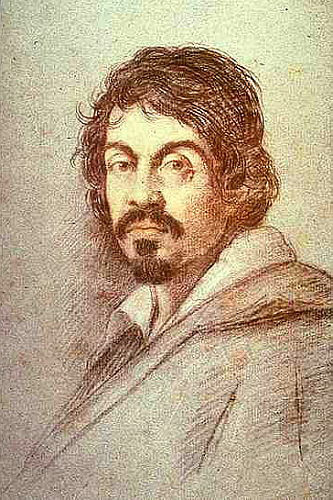
1571 - 1610

Caravaggio, by name of Michelangelo Merisi, Italian painter whose revolutionary technique of tenebrism, or dramatic, selective illumination of form out of deep shadow, became a hallmark of Baroque painting. Scorning the traditional idealized interpretation of religious subjects, he took his models from the streets and painted them realistically. His three paintings of St Matthew (c. 1597-1602) caused a sensation and were followed by such masterpieces as The Supper at Emmaus (1601-02) and Death of the Virgin (1605-06).
Early life
Caravaggio was the son of Fermo Merisi, steward and architect of the Marquis of Caravaggio. Orphaned at age 11, Caravaggio was apprenticed in the same year to the painter Simone Peterzano of Milan.
At some time between 1588 and 1592, Caravaggio went to Rome. He was already in possession of the fundamental technical skills of painting and had acquired, with characteristic eagerness, a thorough understanding of the approach of the Lombard and Venetian painters, who, opposed to idealized Florentine painting, had developed a style that was nearer to representing nature and events. Caravaggio arrived in Rome and settled into the cosmopolitan society of the Campo Marzio. This decaying neighborhood of inns, eating houses, temporary shelter, and little picture shops in which Caravaggio came to live suited his circumstances and his temperament. He was virtually without means, and his inclinations were always toward anarchy and against tradition.
These first five years were an anguishing period of instability and humiliation. According to his biographers, Caravaggio was "needy and stripped of everything" and moved from one unsatisfactory employment to another, working as an assistant to painters of much smaller talent. He earned his living for the most part with hackwork and never stayed more than a few months at any studio. Finally, probably in 1595, he decided to set out on his own and began to sell his pictures through a dealer, a certain Maestro Valentino, who brought Caravaggio's work to the attention of Cardinal Francesco del Monte, a prelate of great influence in the papal court. Caravaggio soon came under the protection of Del Monte and was invited to receive board, lodging, and a pension in the house of the cardinal.
Despite spiritual and material deprivations, Caravaggio had painted up to the beginning of Del Monte's patronage about 40 works. The subjects of this period are mostly adolescent boys, as in Boy with a Fruit Basket (1593; Borghese Gallery, Rome), The Young Bacchus (1593; Uffizi Gallery, Florence), and The Music Party (Metropolitan Museum of Art, New York). These early pictures reveal a fresh, direct, and empirical approach; they were apparently painted directly from life and show almost no trace of the academic Mannerism then prevailing in Rome. The felicitous tone and confident craftsmanship of these early works stand in sharp contrast to the daily quality of Caravaggio's disorderly and dissipated life. In Basket of Fruit (1596; Pinacoteca Ambrosiana, Milan) the fruits, painted with brilliance and vivid realism, are handsomely disposed in a straw basket and form a striking composition in their visual apposition.
Major Roman Commissions
With these works realism won its battle with Mannerism, but it is in the cycle of the life of St Matthew in the Contarelli Chapel that Caravaggio's realistic naturalism first fully appears. Probably through the agency of Del Monte, Caravaggio obtained, in 1597, the commission for the decoration of the Contarelli Chapel in the Church of San Luigi dei Francesi in Rome. This commission established him, at the age of 24, as a pictor celeberrimus, a "renowned painter," with important protectors and clients. The task was an imposing one. The scheme called for three large paintings of scenes from the saint's life: St Matthew and the Angel, The Calling of St Matthew, and The Martyrdom of St Matthew. The execution (1598-1601) of all three, in which Caravaggio substituted a dramatic contemporary realism for the traditional pictorial formulas used in depicting saints, provoked public astonishment. Perhaps Caravaggio was waiting for this test, on public view at last, to reveal the whole range of his diversity. His novelty in these works not only involves the surface appearance of structure and subject but also the sense of light and even of time. The first version of the canvas that was to go over the altar, St Matthew and the Angel, was so offensive to the canons of San Luigi dei Francesi, who had never seen such a representation of a saint, that it had to be redone. In this work the evangelist has the physical features of a plowman or a common labourer. His big feet seem to stick out of the picture, and his posture, legs crossed, is awkward almost to the point of vulgarity. The angel does not stand graciously by but forcefully pushes Matthew's hand over the page of a heavy book, as if he were guiding an illiterate. What the canons did not understand was that Caravaggio, in elevating this humble figure, was copying Christ, who had himself raised Matthew from the street.
The other two scenes of the St Matthew cycle are no less disconcerting in the realism of their drama. The Calling of St Matthew shows the moment at which two men and two worlds confront each other: Christ, in a burst of light, entering the room of the toll collector, and Matthew, intent on counting coins in the midst of a group of gaily dressed idlers with swords at their sides. In the glance between the two men, Matthew's world is dissolved. In The Martyrdom of St Matthew the event is captured just at the moment when the executioner is forcing his victim to the ground. The scene is a public street, and, as Matthew's acolyte flees in terror, passersby glance at the act with idle unconcern. The most intriguing aspect of these narratives is that they seem as if they were being performed in thick darkness when a sudden illumination revealed them and fixed them in memory at the instant of their most intense drama.
Caravaggio's three paintings for the Contarelli Chapel not only caused a sensation in Rome but also marked a radical change in his artistic preoccupation. Henceforth he would devote himself almost entirely to the painting of traditional religious themes, to which, however, he gave a whole new iconography and interpretation. He often chose subjects that are susceptible to a dramatic, violent, or macabre emphasis, and he proceeded to divest them of their idealized associations, taking his models from the streets. Caravaggio may have used a lantern hung to one side in his shuttered studio while painting from his models. The result in his paintings is a harsh, raking light that strikes across the composition, illuminating parts of it while plunging the rest into deep shadow. This dramatic illumination heightens the emotional tension, focuses the details, and isolates the figures, which are usually placed in the foreground of the picture in a deliberately casual grouping. This insistence on clarity and concentration, together with the firm and vigorous drawing of the figures, links Caravaggio's mature Roman works with the classical tradition of Italian painting during the Renaissance.
The decoration of the Contarelli Chapel was completed by 1602. Caravaggio, though not yet 30, overshadowed all his contemporaries. There was a swarm of orders for his pictures, private and ecclesiastical. The Crucifixion of St Peter (1601) and The Conversion of St Paul (both in Santa Maria del Popolo, Rome), The Deposition of Christ (1602-04; Vatican Museum, Rome), and the Death of the Virgin (1605-06; Louvre Museum, Paris) are among the monumental works he produced at this time. Some of these paintings, done at the high point of Caravaggio's artistic maturity, provoked violent reaction. The Madonna with Pilgrims, or Madonna di Loreto (1603-06), for the Church of San Agostino, was a scandal because of the "dirty feet and torn, filthy cap" of the two old people kneeling in the foreground. The Death of the Virgin was refused by the Carmelites because of the indignity of the Virgin's plebeian features, bared legs, and swollen belly. At the advice of the painter Peter Paul Rubens, the picture was bought by the Duke of Mantua in April 1607 and displayed to the community of painters at Rome for one week before removal to Mantua.
Culmination of Mature Style
Artists, men of learning, and enlightened prelates were fascinated by the robust and bewildering art of Caravaggio, but the negative reaction of church officials reflected the self-protective irritation of academic painters and the instinctive resistance of the more conservative clergy and much of the populace. The more brutal aspects of Caravaggio's paintings were condemned partly because Caravaggio's common people bear no relation to the graceful suppliants popular in much of Counter-Reformation art. They are plain working men, muscular, stubborn, and tenacious.
Criticism did not cloud Caravaggio's success, however. His reputation and income increased, and he began to be envied. The despairing bohemian of the early Roman years had disappeared, but, although he moved in the society of cardinals and princes, the spirit was the same, still given to wrath and riot.
The details of the first Roman years are unknown, but after the time of the Contarelli project Caravaggio had many encounters with the law. In 1600 he was accused of blows by a fellow painter, and the following year he wounded a soldier. In 1603 he was imprisoned on the complaint of another painter and released only through the intercession of the French ambassador. In April 1604 he was accused of throwing a plate of artichokes in the face of a waiter, and in October he was arrested for throwing stones at the Roman Guards. In May 1605 he was seized for misuse of arms, and on July 29 he had to flee Rome for a time because he had wounded a man in defense of his mistress. Within a year, on May 29, 1606, again in Rome, during a furious brawl over a disputed score in a game of tennis, Caravaggio killed one Ranuccio Tomassoni.
Flight from Rome
In terror of the consequences of his act, Caravaggio, himself wounded and feverish, fled the city and sought refuge on the nearby estate of a relative of the Marquis of Caravaggio. He then moved on to other places of hiding and eventually reached Naples, probably in early 1607. He remained at Naples for a time, painting a Madonna of the Rosary for the Flemish painter Louis Finson and one of his late masterpieces, The Seven Works of Mercy, for the Chapel of Monte della Misericordia. It is impossible to ignore the connection between the dark and urgent nature of this painting and what must have been his desperate state of mind. It is also the first indication of a shift in his painting style.
At the end of 1607 or the beginning of 1608, Caravaggio traveled to Malta, where he was received as a celebrated artist He worked hard, completing several works, the most important of which was The Beheading of St John the Baptist for the cathedral in Valletta. In this scene of martyrdom, shadow, which in earlier paintings stood thick about the figures, is here drawn back, and the infinite space that had been evoked by the huge empty areas of the earlier compositions is replaced by a high, overhanging wall. This high wall, which reappears in later works, can be linked to a consciousness in Caravaggio's mind of condemnation to a limited space, the space between the narrow boundaries of flight and prison. On July 14, 1608, Caravaggio was received into the Order of Malta as a "Knight of Justice"; soon afterward, however, either because word of his crime had reached Malta or because of new misdeeds, he was expelled from the order and imprisoned. He escaped, however.
Caravaggio took refuge in Sicily, landing at Syracuse in October 1608, restless and fearful of pursuit. Yet his fame accompanied him; at Syracuse he painted his late, tragic masterpiece, The Burial of St Lucy, for the Church of Santa Lucia. In early 1609 he fled to Messina, where he painted The Resurrection of Lazarus and The Adoration of the Shepherds (both now in the National Museum, Messina), then moved on to Palermo, where he did the Adoration with St Francis and St Lawrence for the Oratorio di San Lorenzo. The works of Caravaggio's flight, painted under the most adverse of circumstances, show a subdued tone and a delicacy of emotion that is even more intense than the overt dramatics of his earlier paintings.
His desperate flight could be ended only with the pope's pardon, and Caravaggio may have known that there were intercessions on his behalf in Rome when he again moved north to Naples in October 1609. Bad luck pursued him, however; at the door of an inn he was attacked and wounded so badly that rumours reached Rome that the "celebrated painter" was dead. After a long convalescence he sailed in July 1610 from Naples to Rome, but he was arrested enroute when his boat made a stop at Palo. On his release, he discovered that the boat had already sailed, taking his belongings. Setting out to overtake the vessel, he arrived at Port'Ercole, a Spanish possession within the Papal States, and he died there a few days later, probably of pneumonia. A document granting him clemency arrived from Rome three days after his death.
Influence
The many painters who imitated Caravaggio's style soon became known as Caravaggisti. Caravaggio's influence in Rome itself was remarkable but short-lived, lasting only until the 1620s. His foremost followers elsewhere in Italy were Orazio Gentileschi, Artemisia Gentileschi, and the Spaniard José de Ribera. Outside Italy, the Dutch painters Hendrick Terbrugghen, Gerrit van Honthorst, and Dirck van Baburen made the city of Utrecht the foremost northern centre of Caravaggism. The single most important painter in the tradition was the Frenchman Georges de La Tour, though echoes of Caravaggio's style can also be found in the works of such giants as Rembrandt van Rijn and Diego Velázquez.
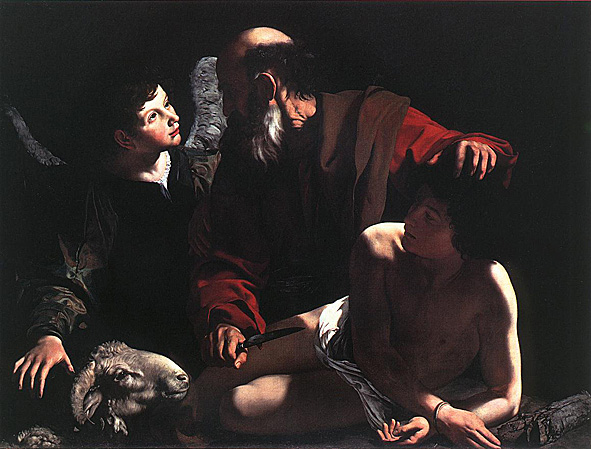
The Sacrifice of Isaac in the Piasecka-Johnson Collection in Princeton, New Jersey is a disputed work which, if genuinely by Caravaggio, would seem to date from the 1590s. According to Giulio Mancini, a contemporary of Caravaggio and an early biographer, the artist, while convalescing in the Hospital of the Consolazione, did a number of paintings for the prior who took them home with him to Seville. (The hospital had a Spanish prior from 1593 to around mid-1595). This would date the work to the mid-1590s, but it seems far more sophisticated than anything else known from that period of Caravaggio's career, and Peter Robb, in his 1998 biography of Caravaggio, dates it to about 1598. The model for Isaac bears a close resemblance to the model used for the John the Baptist now in the museum of Toledo cathedral, which suggests that the two should be considered together. The presence of paintings by Caravaggio in Spain at an early date is important for the influence they may have had on the young Velazquez, but there is also strong evidence that they may have been the work of Bartolomeo Cavarozzi, a talented early member of the Caravaggisti who is known to been in Spain about 1617-1619.
The painting shows the moment when Abraham, about to sacrifice his son Isaac in obedience to God's command, is stayed by an angel who offers him a ram in Isaac's place. The scene is lit with the dramatically enhanced chiaroscuro (tenebrism) with which Caravaggio was to revolutionize Western art, falling like a stage spotlight on the face of the youthful angel; the faces of Abraham and Isaac are in shadow, but show acute emotions; the gestures of the hands are acutely eloquent, the angel's resting on the ram's head in imitation of the way Abraham's left hand rests on the head of his son, the Patriarch's other hand holding the knife but already relaxing as he listens to the angel. The three figures and the ram are shown without background or context, with nothing to distract from the powerful psychological drama as God's promise is delivered.
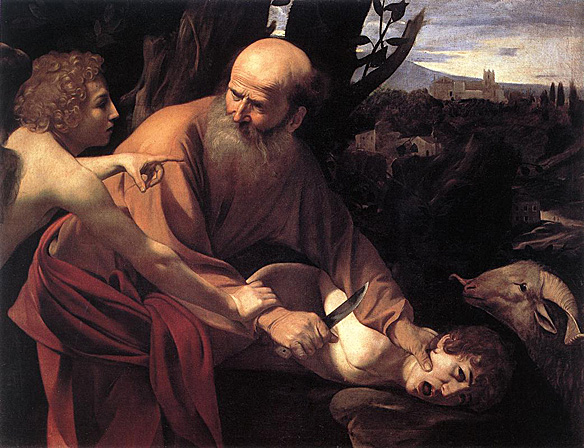
The second Sacrifice of Isaac is housed in the Uffizi Gallery, Florence. According to the early biographer Giovanni Bellori, Caravaggio painted a version of this subject for Cardinal Maffeo Barberini, the future Pope Urban VIII and a series of payments totaling one hundred scudi were made to the artist by Barberini between May 1603 and January 1604. Caravaggio had previously painted a Portrait of Maffeo Barberini, which presumably pleased the cardinal enough for him to commission this second painting.
The artist thrusts the action to the front of the picture frame like a sculpted frieze. Old Abraham, with features reminiscent of the saint in the second St. Matthew, is intercepted in the act of slitting his son's throat by an admonishing angel who with his right hand prevents the sacrifice and with his left points to the substitute victim. Light directs the viewer to scan the scene from left to right as it picks out the angel's shoulder and left hand, the quizzical face of Abraham, the right shoulder and terrified face of Isaac and finally the docile ram. A continuous movement links the back of the angel's neck to Isaac's profile.
Caravaggio combines a hint of horror with pastoral beauty. In the foreground the sharp knife is silhouetted against the light on Isaac's arm. In the distance is one of Caravaggio's rare landscapes, a glimpse perhaps of the Alban Hills round Rome and an acknowledgement of the skill of his one serious rival, Annibale Carracci, whose landscapes were particularly admired.
Isaac has been identified as Cecco Boneri, who appeared as Caravaggio's model in several other pictures. Recent X-ray analysis showed that Caravaggio used Cecco also for the angel, and later modified the profile and the hair to hide the resemblance.
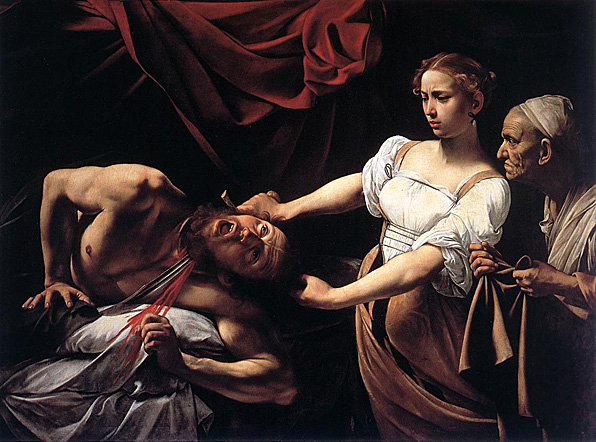

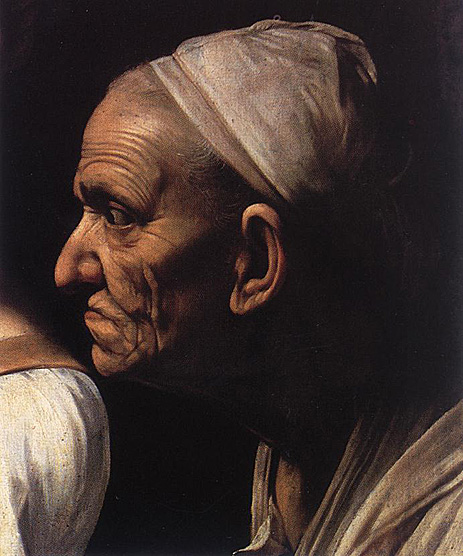
A whole book in some versions of the Bible is devoted to Judith, because as a woman she embodies the power of the people of Israel to defeat the enemy, though superior in numbers, by means of cunning and courage. She seeks out Holofernes in his tent, makes him drunk, then beheads him. The sight of their commander's bloodstained head on the battlements of Bethulia puts the enemy to flight.
In the painting, Judith comes in with her maid - surprisingly and menacingly - from the right, against the direction of reading the picture. The general is lying naked on a white sheet. Paradoxically, his bed is distinguished by a magnificent red curtain, whose color crowns the act of murder as well as the heroine's triumph.
The first instance in which Caravaggio would chose such a highly dramatic subject, the Judith is an expression of an allegorical-moral contest in which Virtue overcomes Evil. In contrast to the elegant and distant beauty of the vexed Judith, the ferocity of the scene is concentrated in the inhuman scream and the body spasm of the giant Holofernes. Caravaggio has managed to render, with exceptional efficacy, the most dreaded moment in a man's life: the passage from life to death. The upturned eyes of Holofernes indicate that he is not alive any more, yet signs of life still persist in the screaming mouth, the contracting body and the hand that still grips at the bed. The original bare breasts of Judith, which suggest that she has just left the bed, were later covered by the semi-transparent blouse.
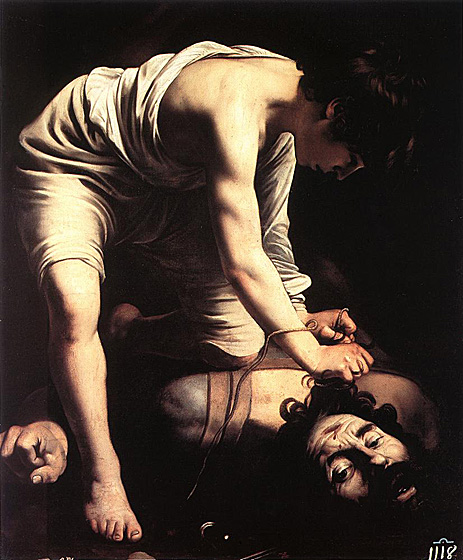
The David and Goliath in the Prado was painted in the early part of the artist's career, while he was a member of the household of Cardinal Francesco Maria Del Monte. It shows the Biblical David as a young boy (in accordance with the Bible story) fastening the head of the champion of the Philistines, the giant Goliath, by the hair. The light catches on David's leg, arm and flank, on the massive shoulders from which Goliath's head has been severed, and on the head itself, but everything else is dark. Even David's face is almost invisible in the shadows. A wound on Goliath's forehead shows where he has been felled by the stone from David's sling. The overwhelming impression is of some action intensely personal and private - no triumph, no armies, no victory.
Caravaggio originally showed Goliath's face fixed in wild-eyed open-mouthed terror, tongue rolling, eyeballs swiveled to the edges of the sockets. In the finished painting the melodrama is banished: the drama is transferred from Goliath to the quietly efficient David, his face almost hidden, intent on the work of his hands in his enemy's hair, kneeling almost casually on the man's torso.
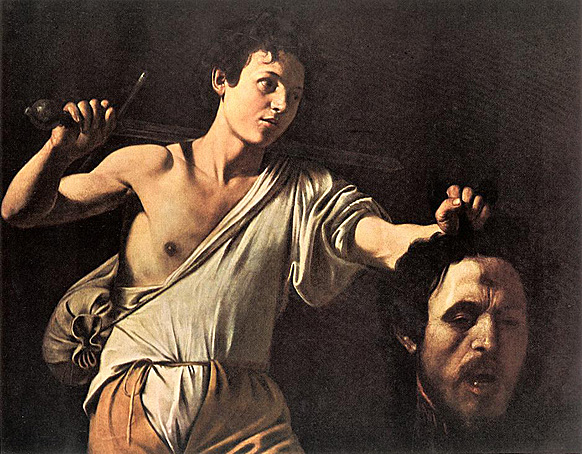
The exact moment depicted appears to be that referred to in I Samuel 17:57: "When David came back after killing the Philistine, Abner took him and presented him to Saul with the Philistine's head still in his hand." The pose is a usual one for the episode, showing David striding in triumph with the head in his hand. In the Boghese version this has changed to an unconventional frontal presentation of the head toward the viewer, who is thereby placed in the position of Saul.
The painting can be compared with the David with the Head of Goliath in the Galleria Borghese, which dates from either 1607 or 1609/10. The two are very similar - Caravaggio frequently explored a subject in multiple variations, most notably his many versions of John the Baptist - but the Vienna painting is less 'dark' in mood, the David more triumphant than the introspective and oddly compassionate David of the Borghese, and the head of Goliath, widely accepted as a self-portrait of the artist in the Borghese, is more generic.

This painting, which was in the collection of Cardinal Scipione Borghese in 1613, has been dated as early as 1605 and as late as 1609-1610. It is included in the list of candidates as Caravaggio's last work. Its melancholy would suit in fact the gloomy thoughts of the artist's final years. The subject matter recalls the Beheading of St. John the Baptist in La Valletta, but this time there is no brilliant color and, as a small picture, it has an intimacy that was not evident in the grand public work.
The boy handles his trophy with disgust. "In that head [Caravaggio] wished to portray himself and in the boy he portrayed his Caravaggino", wrote Manilli in 1650. If Goliath's head is indeed Caravaggio's, there is an element of self disgust in this painting. The device recalls the way that Michelangelo, in the Last Judgment for the Sistine Chapel, placed an anguished face with features evidently his own onto the flayed body of St. Bartholomew, but Caravaggio's mood is closer to one of despair. As a witness to God's light, Bartholomew takes his seat in heaven: Goliath, God's enemy, is doomed to everlasting night.
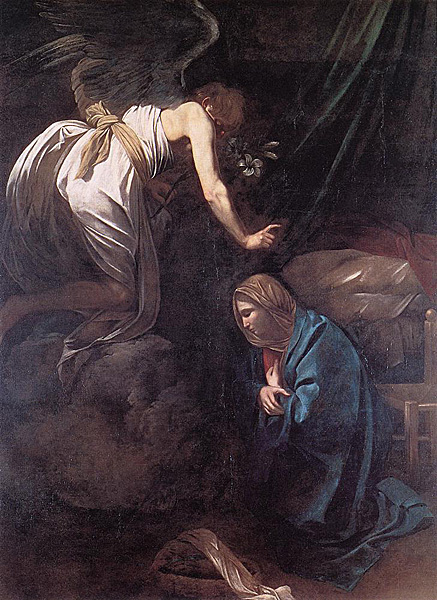
Caravaggio painted church paintings during his last period in Naples. There is reason to believe that the artist's last altarpiece is the Annunciation that reached the high altar of the cathedral of Nancy in Lorrain just after the church was founded (1609). Today it is in the museum of that city.
Whether the painting was made in Sicily or in Naples is not known. Its style would seem to exclude earlier datings, for it is clearly a very late work. It has been pointed out that the angel comes into the painting from real space, canceling the separation between the picture and the viewer in a way typical of the baroque aesthetic. The angel's face is practically invisible. The Virgin does not look at him, she is completely self-absorbed, her pose is devoid of joyous acceptance. She seems instead crushed by the expectation of an unbearable future. The spiritual testament that Caravaggio left us with this large, two-figural painting, where once again the Virgin is not distinguished by deifying attributes, is an infinite existential sadness, which seems to contain no hope of redemption.
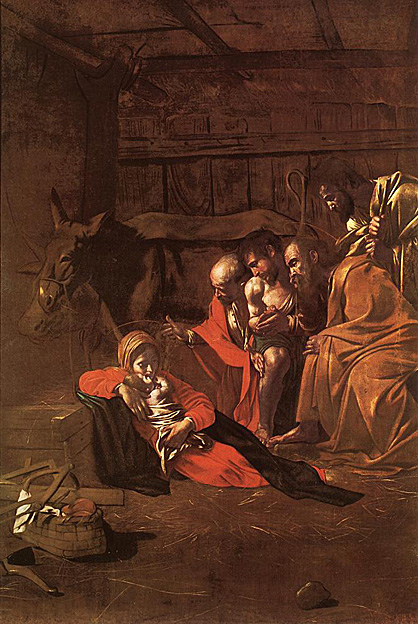
While in Messina, Caravaggio was contracted to paint four scenes of the Passion. If he finished any of them, none now survive. This nativity scene, Susinno says, was ordered by the Senate of Messina for the Capuchin church of Santa Maria degli Angeli.
A Franciscan simplicity pervades the painting. In the wooden barn a donkey and an ox stand patiently at the back, there is straw on the floor and in a basket is a loaf of bread, the carpenter's tools of Joseph and some pieces of cloth. Joseph (in red) introduces the shepherds, in brown and grey, to the young Virgin Mother, whose dress is a brighter red. Mary cuddles her baby peacefully and, apart from two haloes, only the bare-shouldered young man, who kneels with clasped hands, gives the moment of the child's discovery a hint of its meaning - God became man as one of the poor.

The scene is based not on any incident in the Bible itself, but on a body of tales or legends that had grown up in the early Middle Ages around the Bible story of the Holy Family fleeing into Egypt for refuge on being warned that Herod the Great was seeking to kill the Christ Child. According to the legend, Joseph and Mary stopped on the flight in a grove of trees; the Holy Child ordered the trees to bend down so that Joseph could take fruit from them, and then ordered a spring of water to gush forth from the roots so that his parents could quench their thirst. The basic story took on many extra details during the centuries. Caravaggio shows Mary asleep with the infant Jesus, while Joseph holds a manuscript for an angel who is playing a hymn to Mary on the violin. The ass, a traditional ingredient of the legend and a foretelling of the ass that would one day bear Christ into Jerusalem, watches.

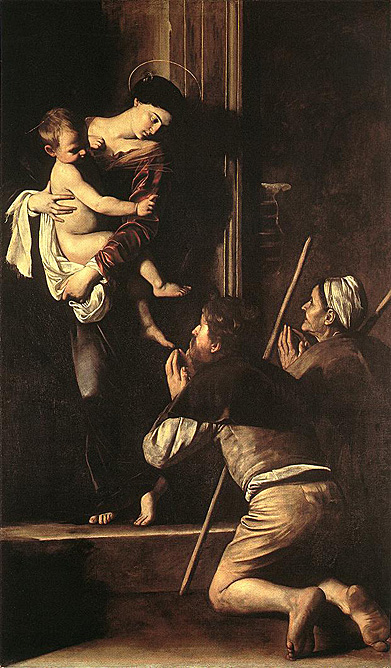
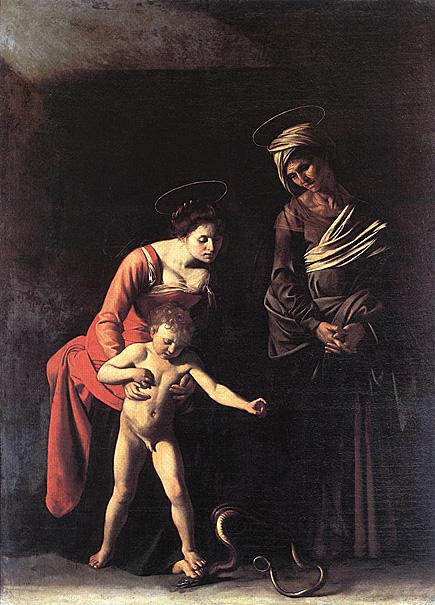
On 16 April 1606, the large, new canvas of the Madonna of the Palafrenieri was removed from one of the most important altars in St. Peter's after only a month, because of its lack of decorum and deviance from figurative tradition. It was then exhibited in Cardinal Borghese's collection in the hall of honor in the palazzo del Borgo and later transferred to the entrance hall in the Villa Borghese.
The novelty of this painting lies in the existential and human drama of the three figures facing danger. St. Anne, in antique style, detachedly contemplates the scene, as Mary teaches the young Jesus how to crush the serpent, symbol of sin and heresy. Darkness envelops the figures set in an undefined place, but an unnaturally bright light bursts forth from above bathing the child's skin in a warm glow.


The painting shows the Biblical sisters Martha and Mary Magdalene - Martha is in the act of converting Mary from her life of pleasure to the life of virtue in Christ. Martha, her face shadowed, leans forward, passionately arguing with Mary, who twirls an orange blossom between her fingers as she holds a mirror, symbolizing the vanity she is about to give up. The power of the image lies in Mary's face, caught at the moment when conversion begins.
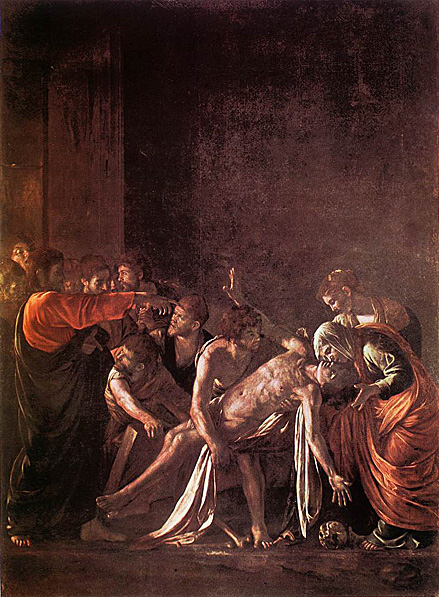
In August 1608 Caravaggio fled from Malta, where he had been imprisoned for an unknown crime, and took refuge in Sicily with his friend, the artist Mario Minniti. Through Minniti's intercession he procured a number of important concessions, including this for the church of the Padri Crociferi in Messina, where it was presented by the wealthy Genoese merchant Giovanni Battista de' Lazzari on 10 June 1609. The fee was a thousand scudi, more than double any Caravaggio had received previously.
The Gospel of St John tells how Lazarus, the brother of Martha and Mary, fell sick, died, was buried and then miraculously raised from the dead by Christ. As in several paintings from this period of Caravaggio's career, the scene is set against blank walls that overwhelm the frieze of human actors. The interaction of the relief of figures caught in corporate effort and emotion, with a large void above, is quite different from the closely focused individualized dramas of his early and middle periods. As is usual with Caravaggio, light becomes an important element in the drama, picking out crucial details such as Lazarus's hands - one lax and open to receive, the other reaching towards Christ - and the wonder-struck faces of the onlookers.
The old story that Caravaggio had a freshly-buried body exhumed for this painting is "probably apocryphal, but not beyond the bounds of possibility". Some of the figures were said to be modeled on members of the community, but Caravaggio has also relied on his memory - the whole design is based on an engraving after Giulio Romano and his Jesus is a reversed image of the Christ who called Matthew to join him in The Calling of Saint Matthew. The painting is in poor condition and much restored, and it's possible that some passages are the work of assistants.
Lazarus, the brother of Martha and Mary, was the patron saint of Giovanni Battista de' Lazzari, to whom Caravaggio was contracted to paint an altarpiece in the church of the Padri Crociferi. The Gospel of St John tells how Lazarus fell sick, died, was buried and then miraculously raised from the dead by Christ.
Most of Caravaggio's religious subjects emphasize sadness, suffering and death. In 1609 he dealt with the triumph of life and in doing so created the most visionary picture of his career.
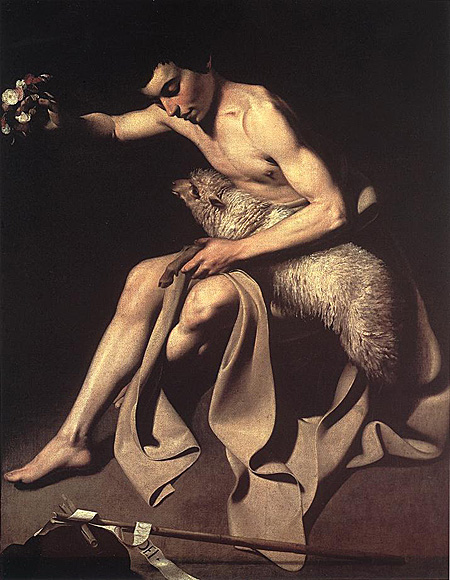

Caravaggio was not the first artist to have treated the Baptist as a cryptic male nude - there were prior examples from Leonardo, Raphael, Andrea del Sarto and others - but he introduced a new note of realism and drama. His John has the roughened, sunburnt hands and neck of a laborer, his pale torso emerging with a contrast that reminds the viewer that this is a real boy who has gotten undressed for his modeling session - unlike Raphael's Baptist, who is as idealized and un-individualized as one of his winged cherubs.
Ask who this model actually is, (or was), and the realism of the individual spills over as a record of Rome itself in the age of Caravaggio. Biographer Peter Robb cites Montaigne on Rome as a city of universal idleness, "...the envied idleness of the higher clerics, and the frightening idleness of the destitute...a city almost without trades or professions, in which the churchmen were playboys or bureaucrats, the laymen were condemned to be courtiers, all the pretty girls and boys seemed to be prostitutes, and all wealth was inherited old money or extorted new." It was not an age which welcomed an art that emphasized the real.
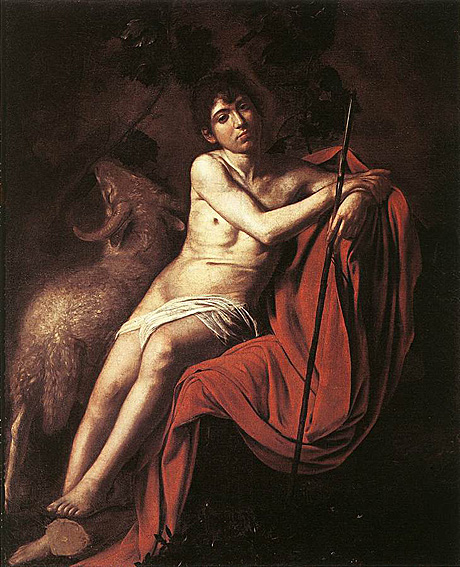
The date of the John the Baptist in the Galleria Borghese is disputed: it was long thought to have been acquired by Cardinal Scipione Borghese some time between his own arrival in Rome in 1605 and Caravaggio's flight from the city in 1606, but Roberto Longhi dated it to the artist's Sicilian period (a date post-1608) on the basis of similarities in handling and colour. Lonhi's view has gained increasing acceptance, with a consensus in favour of 1610 emerging in recent years.
The painting shows a boy slumped against a dark background, where a sheep nibbles at a dull brown vine. The boy is immersed in a reverie: perhaps as Saint John he is lost in private melancholy, contemplating the coming sacrifice of Christ; or perhaps as a real-life street-kid called on to model for hours he is merely bored. As so often with Caravaggio, the sense is of both at once. But the overwhelming feeling is of sorrow. The red cloak envelopes his puny childish body like a flame in the dark, the sole touch of colour apart from the pale flesh of the juvenile saint. "Compared with the earlier Capitolina and Kansas City versions...the Borghese picture is more richly colouristic - an expressive essay in reds, whites, and golden browns. It also represents a less idealised and more sensuous approach to the male nude, as prefigured in the stout-limbed figures of certain of Caravaggio's post-Roman works, such as the Naples Flagellation and the Valletta Beheading of John the Baptist."
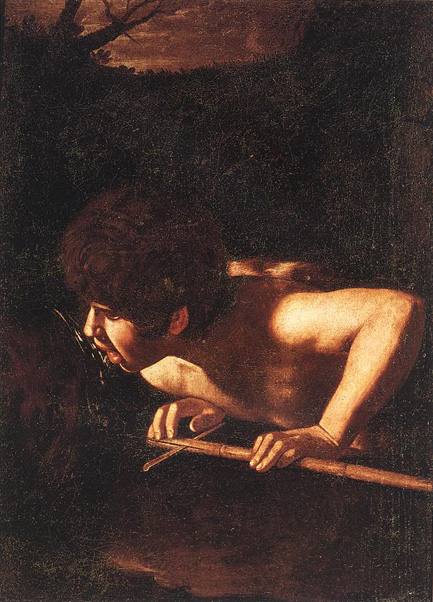
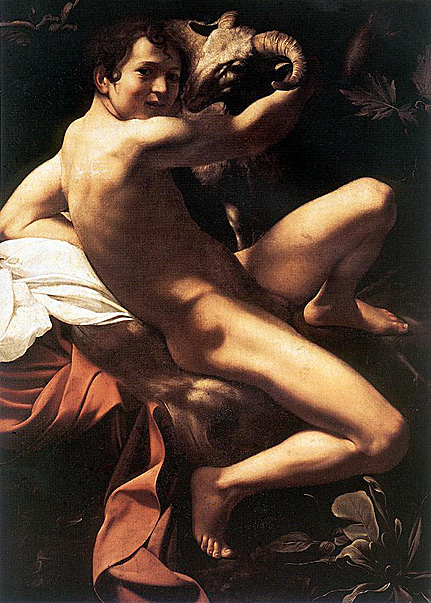
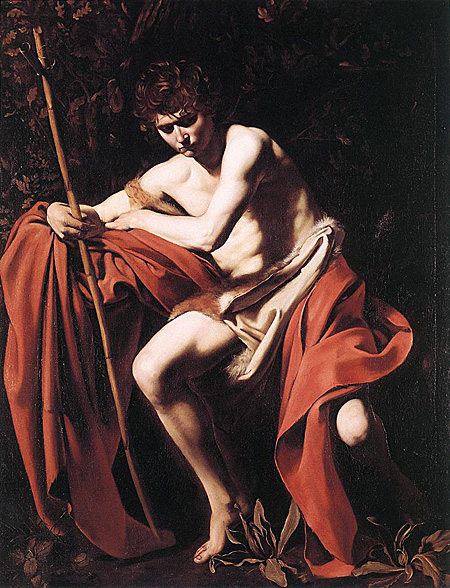
Stark contrasts of light and dark accentuate the perception that the figure leans forward, out of the deep shadows of the background and into the lighter realm of the viewer's own space...The brooding melancholy of the Nelson-Atkins Baptist has attracted the attention of almost every commentator. It seems, indeed, as if Caravaggio instilled in this image an element of the essential pessimism of the Baptist's preaching, of the senseless tragedy of his early martyrdom, and perhaps even some measure of the artist's own troubled psyche. The saint's gravity is at least partly explained, too, by the painting's function as the focal point of the meeting place of a confraternity whose mission was to care for the sick and dying and to bury the corpses of plague victims.
Caravaggio biographer Peter Robb has pointed out that the fourth Baptist seems like a psychic mirror-image of the first, with all the signs reversed: the brilliant morning light which bathed the earlier painting has become harsh and almost lunar in its contrasts, and the vivid green foliage has turned to dry dead brown. There is almost nothing in the way of symbols to identify that this is indeed a religious image, no halo, no sheep, no leather girdle, nothing but the thin reed cross (a reference to Christ's description of John as "a reed shaken by the wind"). The painting demonstrates what Robb calls Caravaggio's "feeling for the drama of the human presence." This adolescent, almost adult, John seems locked in some private world known only to his creator. Caravaggio's conception of the saint as a seated, solitary figure, lacking almost any narrative identity (how do we know this is the Baptist? What is happening here?) was truly revolutionary. Artists from Giotto to Bellini and beyond had shown the Baptist as an approachable story, a symbol understandable to all; the very idea that a work should express a private world, rather than a common religious and social experience, was radically new.
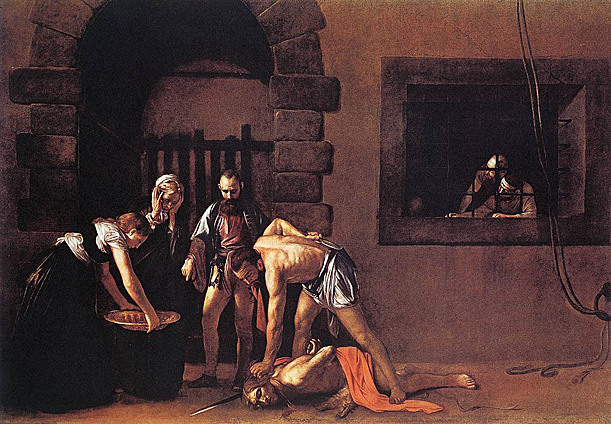
The Beheading of Saint John the Baptist is a painting finished in 1608 by the Italian Baroque painter Caravaggio. It is housed in the St. John's Co-Cathedral of La Valletta, Malta.
The most important painting that Caravaggio made in Malta considered by many to be his greatest masterpiece.
A magical balance of all the parts characterizes the piece. It is no accident that the artist brings into the painting precise reference to the setting, placing behind the figures as a backdrop the severe 16th century architecture of the prison building. At the window two figures silently witness the scene, and the commentators are thus drawn into the painting. They are not projected toward the outside as Caravaggio painted in the Martyrdom of St. Matthew.
Figures well-known to him return (the old woman, the youth, the nude ruffian, the bearded nobleman), as do Lombard elements. The technical means adhere to the deliberate, programmatic limitation to which Caravaggio adapts them; but amid these soft tones, these dark colors, is an impressive sense of drawing that the artist does not give up, and that is visible even through the synoptic glints of light of his late works. This eminently classical balance, which projects the event beyond contingency, unleashes a harsh drama that is even more effective to the extent that, having given up the "aesthetic of exclamation" forever, Caravaggio limits every external, excessive sign of emotional emphasis. The painter signed in the Baptist's blood: "f (perhaps to understood as fecit rather than frater) michela...". This is the seal he placed on what may well be his greatest masterpiece.
According to ten verses of Matthew 14, John was imprisoned for criticizing King Herod Antipas' marriage to Herodias, the former wife of Antipas' "brother" Herod Philip I. Herod offered his niece a reward of her choice for performing a dance on his birthday. Herodias persuaded her daughter to ask for John the Baptist's head on a platter. Against his better judgment, Antipas reluctantly acceded to her request.
The drunken oath of a king with a shallow sense of honor, a seductive dance and the hateful heart of a queen combined to bring about the martyrdom of John the Baptist. The greatest of prophets suffered the fate of so many Old Testament prophets before him: rejection and martyrdom. The "voice crying in the desert" did not hesitate to accuse the guilty, did not hesitate to speak the truth. But why? What possesses a man that he would give up his very life?
This great religious reformer was sent by God to prepare the people for the Messiah. His vocation was one of selfless giving. The only power that he claimed was the Spirit of Yahweh. "I am baptizing you with water, for repentance, but the one who is coming after me is mightier than I. I am not worthy to carry his sandals. He will baptize you with the Holy Spirit and fire" (Matthew 3:11). Scripture tells us that many people followed John looking to him for hope, perhaps in anticipation of some great messianic power. John never allowed himself the false honor of receiving these people for his own glory. He knew his calling was one of preparation. When the time came, he led his disciples to Jesus: "The next day John was there again with two of his disciples, and as he watched Jesus walk by, he said, 'Behold, the Lamb of God.' The two disciples heard what he said and followed Jesus" (John 1:35-37). It is John the Baptist who has pointed the way to Christ. John's life and death were a giving over of self for God and other people. His simple style of life was one of complete detachment from earthly possessions. His heart was centered on God and the call that he heard from the Spirit of God speaking to his heart. Confident of God's grace, he had the courage to speak words of condemnation or repentance, of salvation.
"So they came to John and said to him, 'Rabbi, the one who was with you across the Jordan, to whom you testified, here he is baptizing and everyone is coming to him.' John answered and said, 'No one can receive anything except what has been given him from heaven. You yourselves can testify that I said [that] I am not the Messiah, but that I was sent before him. The one who has the bride is the bridegroom; the best man, who stands and listens for him, rejoices greatly at the bridegroom's voice. So this joy of mine has been made complete. He must increase; I must decrease'" (John 3:26-30).
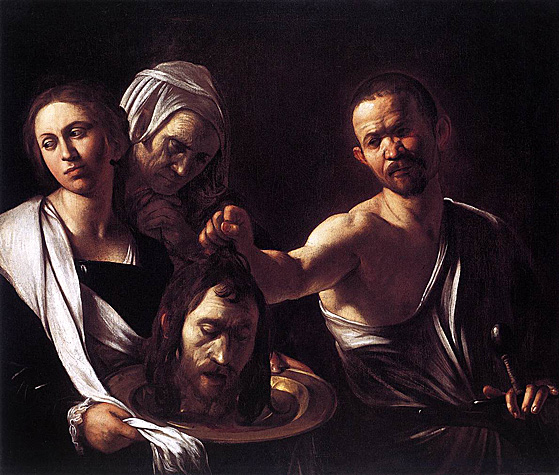
The subject is from the New Testament (Mark 6). Salome had danced so well for King Herod that he swore he would grant her any request. Her mother, Herodias, who sought revenge on John the Baptist, persuaded Salome to ask for his head. The old woman behind Salome may be Herodias.
This is a late work by the artist, painted in the last three years of his life, perhaps in Naples where he resided from 1609 to 1610. No longer concerned with the incidentals of the narrative, Caravaggio focuses on the essential human tragedy of the story.
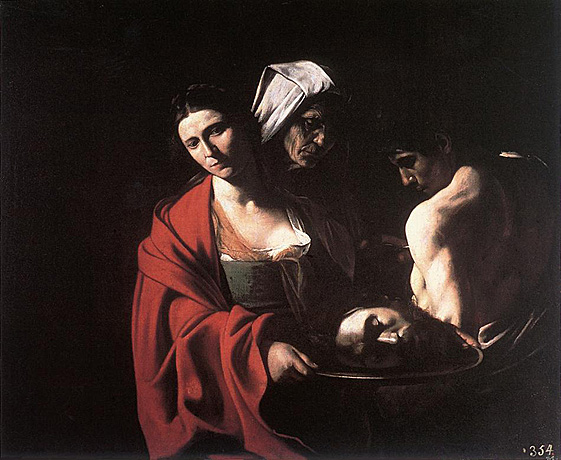
King Herod heard about it, for his fame had become widespread, and people were saying, "John
the Baptist has been raised from the dead; that is why mighty powers are at work in him."
Others were saying, "He is Elijah"; still others, "He is a prophet like any of the prophets."
But when Herod learned of it, he said, "It is John whom I beheaded. He has been raised up."
Herod was the one who had John arrested and bound in prison on account of Herodias, the wife
of his brother Philip, whom he had married.
John had said to Herod, "It is not lawful for you to have your brother's wife."
Herodias harbored a grudge against him and wanted to kill him but was unable to do so.
Herod feared John, knowing him to be a righteous and holy man, and kept him in custody. When
he heard him speak he was very much perplexed, yet he liked to listen to him.
She had an opportunity one day when Herod, on his birthday, gave a banquet for his courtiers,
his military officers, and the leading men of Galilee.
Herodias's own daughter came in and performed a dance that delighted Herod and his guests.
The king said to the girl, "Ask of me whatever you wish and I will grant it to you."
He even swore (many things) to her, "I will grant you whatever you ask of me, even to half of
my kingdom."
She went out and said to her mother, "What shall I ask for?" She replied, "The head of John the
Baptist."
The girl hurried back to the king's presence and made her request, "I want you to give me at once
on a platter the head of John the Baptist."
The king was deeply distressed, but because of his oaths and the guests he did not wish to break
his word to her.
So he promptly dispatched an executioner with orders to bring back his head. He went off and
beheaded him in the prison.
He brought in the head on a platter and gave it to the girl. The girl in turn gave it to her mother.
When his disciples heard about it, they came and took his body and laid it in a tomb.
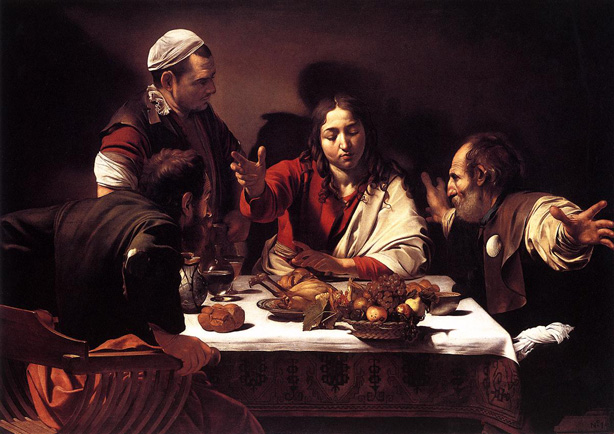
The gospel according to St Luke (24:13-32) tells of the meeting of two disciples with the resurrected Christ. It is only during the meal that his companions recognize him in the way he blesses and breaks the bread. But with that, the vision of Christ vanishes. In the gospel according to St Mark (16:12) he is said to have appeared to them "in an other form" which is why Caravaggio did not paint him with a beard at the age of his crucifixion, but as a youth.
The host seems interested but somewhat confused at the surprise and emotion shown by the disciples. The light falling sharply from the top left to illuminate the scene has all the suddenness of the moment of recognition. It captures the climax of the story, the moment at which seeing becomes recognizing. In other words, the lighting in the painting is not merely illumination, but also an allegory. It models the objects, makes them visible to the eye and is at the same time a spiritual portrayal of the revelation, the vision, that will be gone in an instant.
Caravaggio has offset the transience of this fleeting moment in the tranquillity of his still life on the table. On the surfaces of the glasses, crockery, bread and fruit, poultry and vine leaves, he unfurls all the sensual magic of textural portrayal in a manner hitherto unprecedented in Italian painting.
The realism with which Caravaggio treated even religious subjects - apostles who look like labourers, the plump and slightly feminine figure of Christ - met with the vehement disapproval of the clergy.
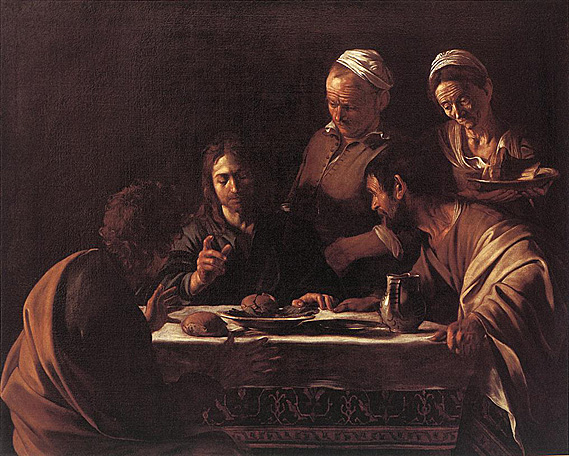
The painting inevitably invites comparison with the National Gallery version of the same subject: the expansive theatrical gestures have become understated and natural, the shadows are darkened, and the colors muted although still saturated. The effect is to emphasize presence more than drama. Some details - the ear of the disciple on the right, the right hand of the innkeeper's wife - remain badly drawn, but there is a fluidity in the handling of the paint which was to increase in Caravaggio's post-Roman work as his brushwork became increasingly calligraphic. The artist may have had problems working out his composition - the innkeeper's wife looks like a last-minute addition. Neither she nor the innkeeper are mentioned in the Gospel of Luke 24:28-32, but had been introduced by Renaissance painters to act as a foil to the amazement of the two disciples as they recognize the resurrected Christ.
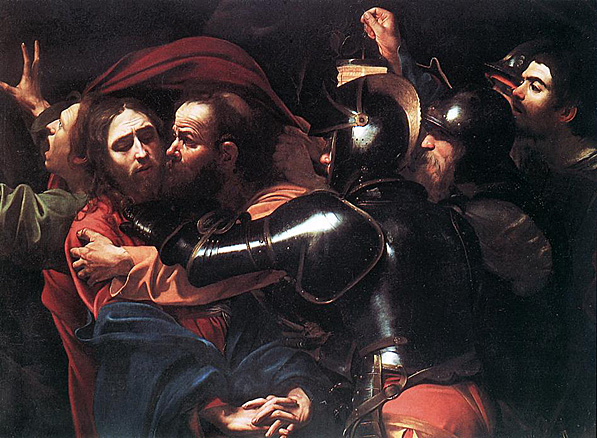
This is a remarkable treatment of the familiar story of betrayal. Judas Iscariot, one of the twelve Apostles, agrees to lead soldiers of the High Priest to arrest Jesus. He will identify the man by kissing him.
In this picture, he main figures of Jesus and Judas are pushed to the left, so that the right-hand half of the picture is left to the soldiers, whose suits of armor absorb what little light there is, and whose faces are the most part hidden. At the right of the picture, an unhelmeted head emerges from the surrounding darkness. This is often regarded as the artist's self-portrait. Caravaggio has also concerned himself here with the act of seeing as one of a painter's task. The three men on the right are there mainly to intensify the visual core of the painting, underscored by the lantern.

Peter is shown before a fireplace in the courtyard of the high priest, where a woman accuses him of being a follower of Christ. The pointing finger of the soldier and two pointing fingers of the woman allude to the three accusations and to Peter's three denials.
The picture, a marvel of narrative as well as pictorial concision, was painted by Caravaggio in the last months of his tempestuous life and marks an extreme stage in his revolutionary style. In it he eschews delicacy and beauty of color and, with extraordinary psychological penetration, concentrates exclusively on the human drama. The painting is first recorded in 1624 in the Savelli collection in Rome, where it was studied by a number of artists.
Caravaggio's late works depend for their dramatic effect on brightly lit areas standing in stark contrast to a dark background. These effects become exaggerated over time as the paint becomes more transparent.
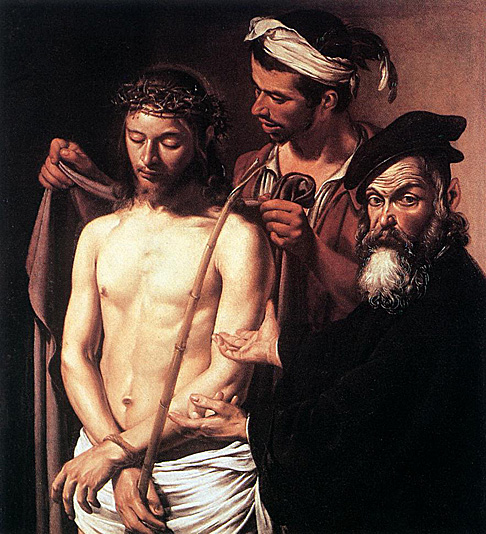
Ecce Homo: The scene is from the Gospel of John (John 19): Pontius Pilate displays Christ to the crowd with the words, "Ecce homo!" ("Behold the man" - the man the crowd wishes to crucify). Caravaggio has combined Pilate's displaying of Christ with the slightly earlier moment when Christ, already crowned with thorns, is mockingly robed like a king by his tormentors.
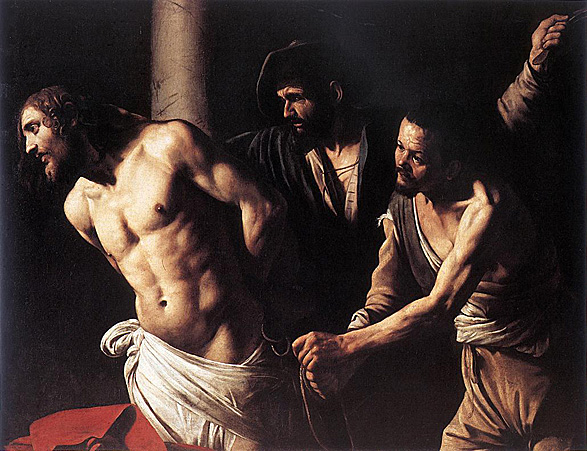
This is one of two versions of the Flagellation of Christ by Caravaggio painted late in 1606 or early in 1607, soon after his arrival in Naples. The painting shows the flagellation of Christ following his arrest and trial and before his crucifixion. The scene was traditionally depicted in front of a column, possibly alluding to the judgment hall of Pilate. The snub-nosed torturer on the far right is recognizably the same figure who modeled as one of the torturers in The Flagellation of Christ, and as the executioner in Salome with the Head of John the Baptist.
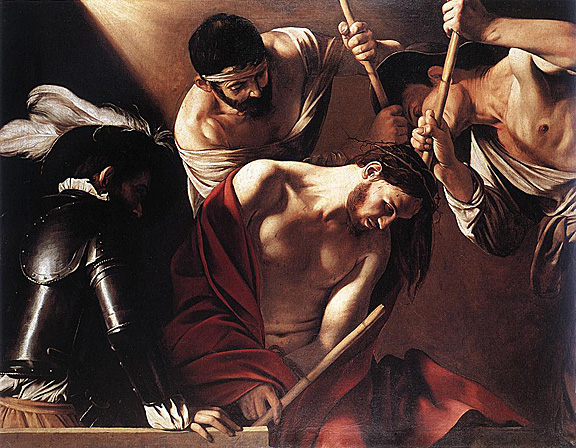
The Crowning with Thorns is a painting by the Italian master Michelangelo Merisi da Caravaggio. Executed probably in 1602/1604 or possibly around 1607, it is now located in the Kunsthistorisches Museum, Vienna.
The theme of pain and sadism is certainly central to the work. John Gash points to the way the two torturers ram the crown down with the butts of their staffs, "a rhythmic and sadistic hammering." (Actually Gash believes that the torturer on the left is about to bring his stick down on the near, visible side of Christ's head, but this seems physically impossible). Robb mentions that the painting is about "how ... to give pain and feel pain, and how close pain and pleasure sometimes were, how voluptuous suffering could be on a golden afternoon." For Robb, however, the problem with the painting is "that recurrent bugbear of Christian art, the slack and passive figure of Christ, ... sitting out a hair shampoo at the barber's...".
Caravaggio's patron Vincenzo Giustiniani was an intellectual as well as a collector, and late in life he wrote a paper about art, identifying twelve grades of accomplishment. In the highest class he put just two names, Caravaggio and Annibale Carracci, as artists capable of combining realism and style in the most accomplished manner. This Crowning with Thorns illustrates what Giustiniani meant: the cruelty of the two torturers is depicted with acutely observed reality as they hammer home the thorns, as is the bored slouch of the official leaning on the rail as he oversees the death of God. While Christ, despite what Robb says, is suffering real pain with patient endurance; all depicted within a classical composition of contrasting and intersecting horizontals and diagonals.
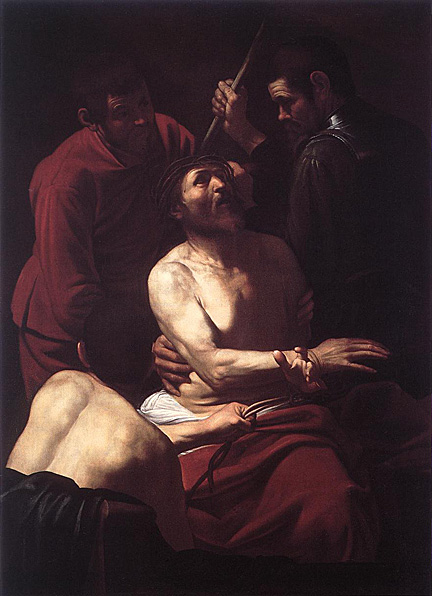
The Crowning with Thorns was the subject of two paintings by the Italian master Caravaggio. The first version, dated to around 1604/1605, is now in the Cassa di Risparmi e Depositi of Palazzo degli Alberti, Prato (Tuscany). The attribution to Caravaggio is disputed.
On June 25, 1605 Caravaggio wrote out, in his own hand, a contract to paint "a picture of the same size and value as the one I have already done for him of Christ's crowning," which restricts the Crowning to a period prior to this date. There is no firm evidence for a more precise dating, but the figure of Christ has been clearly influenced by the Christ in Ruben's alterpiece of The Crowning with Thorns in the Church of Santa Croce in Gerusalemme, Rome, completed in April 1602. The recipient of both the Crowning with Thorns and the Ecce Homo-the painting to which the contract relates-was Massimo Massimi, a wealthy financier and art collector in the circle of Caravaggio's patron Marchese Vincenzo Giustiniani.
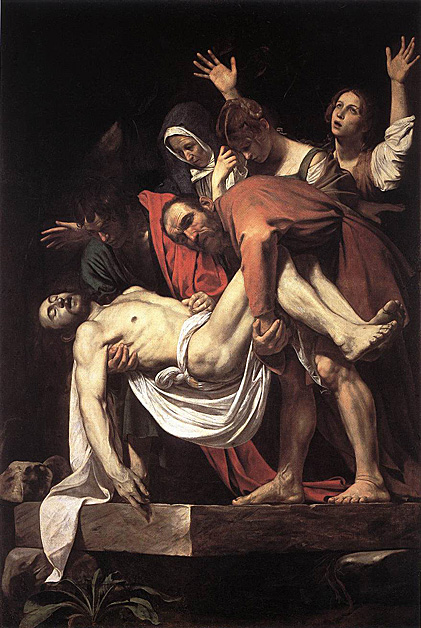
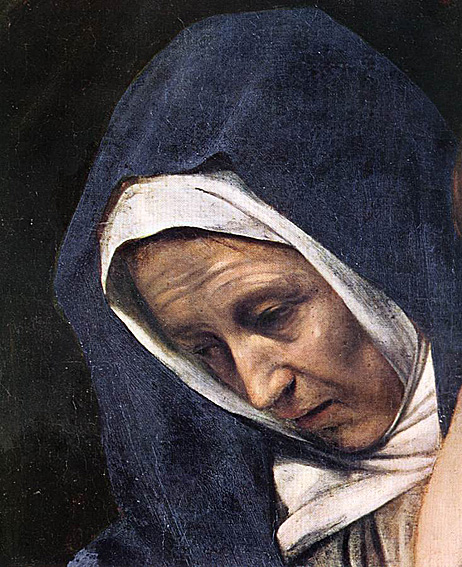
The painting is from the altar of the Chiesa Nuova in Rome, which is dedicated to the Pietà. The embalming of the corpse and the entombment are actually secondary to the Mourning of Mary which is the focal point of the lamentation.
Nothing distinguished Caravaggio's history paintings more strongly from the art of the Renaissance than his refusal to portray the human individual as sublime, beautiful and heroic. His figures are bowed, bent, cowering, reclining or stooped. The self confident and the statuesque have been replaced by humility and subjection.
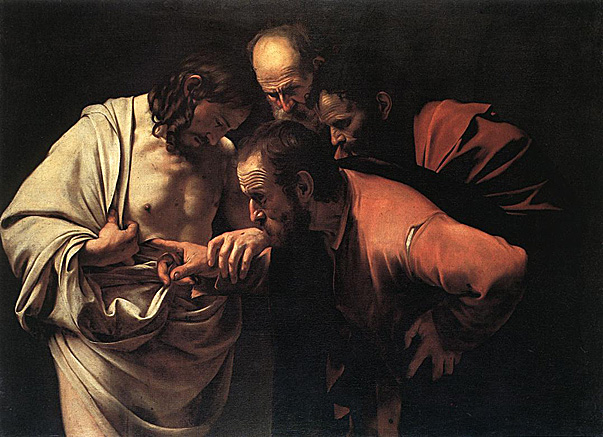
This picture seems to belong to the same group as The Inspiration of Saint Matthew and the Uffizi The Sacrifice of Isaac because the same model reappears as the apostle at the apex of this composition. Like Saint Matthew and the Angel this picture belonged to Vincenzo Giustiniani and then entered the Prussian royal collection. Fortunately it was kept in Potsdam and so it survived the last war intact. This is the most copied painting of Caravaggio, 22 copies from the 17th century are known.
According to St John's Gospel, Thomas missed one of Christ's appearances to the Apostles after His resurrection. He therefore announced that, unless he could thrust his hand into Christ's side, he would not believe what he had been told. A week later Christ appeared, asked Thomas to reach out his hands to touch Him and said, "Blessed are those who have not seen and yet have believed."
This drama of disbelief seems to have touched Caravaggio personally. Few of his paintings are physically so shocking - his Thomas pushes curiosity to its limits before he will say, "My Lord and my God". The classical composition carefully unites the four heads in the quest for truth. Christ's head is largely in shadow, as He is the person who is the least knowable.

The Conversion of Saint Paul (or Conversion of Saul), by the Italian painter Caravaggio, is housed in the Odescalchi Balbi Collection of Rome. It is one of at least two paintings by Caravaggio of the same subject. Another is The Conversion of Saint Paul on the Road to Damascus, in the Cerasi Chapel of Santa Maria del Popolo.
The painting, together with a Crucifixion of Saint Peter, was commissioned by Monsignor (later Cardinal) Tiberio Cerasi, Treasurer-General to Pope Urban VIII, in September 1600. According to Caravaggio's early biographer Giovanni Baglione, both paintings were rejected by Cerasi, and replaced by the second versions which hang in the chapel today. The dates of completion and rejection are determined from the death of Cerasi in May 1601. Baglione states that the first versions of both paintings were taken by Cardinal Giacomo Sannessio, but another early writer, Giulio Mancini, says that Sannessio's paintings were copies. Nevertheless, most scholars are satisfied that this is the first version of the Conversion of Paul.
The painting records the moment when the Levite Saul, on his way to Damascus to annihilate the Christian community there, is struck blind by a brilliant light and hears the voice of Christ saying, "Saul, Saul, why persecute thou me?...And they that were with me saw indeed the light, and were afraid, but they heard not the voice..." (Acts 22:6-11). Elsewhere Paul claims to have seen Christ during the vision, and it is on this basis that he claims be recognized as an Apostle: "Have I not seen Jesus Christ our Lord?" (I Corinthians 9:1).
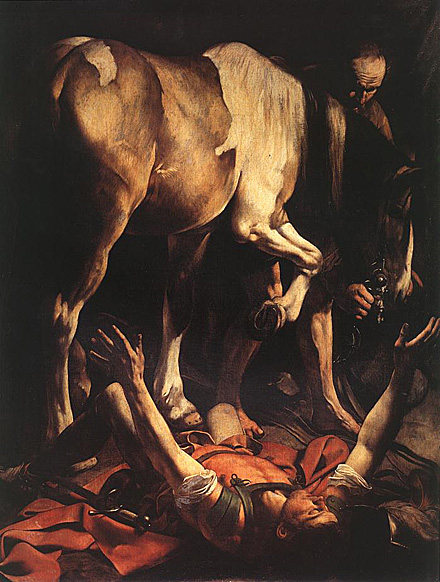
The Conversion on the Way to Damascus (Conversione di San Paolo) is a masterpiece by Michelangelo Merisi da Caravaggio, painted in 1601 for the Cerasi Chapel of the church of Santa Maria del Popolo, in Rome. Across the chapel is a second Caravaggio painting (1600) depicting the inverted Crucifixion of St. Peter. On the altar, is a luminous and crowded Assumption of the Virgin Mary by Annibale Carracci. The dome frescoes are by one of Carracci's apprentices, under his design. The chapel was painted for Monsignor Tiberio Cerasi, who died in 1601 and had been treasurer general under Clement VIII. The commission for Caravaggio (and perhaps Carracci) was apparently secured by his newly acquired patron, Marchese Vicenzo Guistiniani.
The painting depicts the moment recounted in Chapter 9 of Acts of the Apostles when Saul, soon to be the apostle Paul, fell on the road to Damascus. He heard the Lord say "I am Jesus, whom you persecute, arise and go into the city." The Golden Legend, a compilation of medieval interpretations of biblical events may have framed the event for Caravaggio.
On this canvas, Saul is an epileptic and fractured figure, flattened by the divine flash, flinging his arms upward in a funnel. There are three figures in the painting. The commanding muscular horse dominates the canvas, yet it is oblivious to the divine light that defeated his rider's gravity. The aged groom is human, but gazes earthward, also ignorant of the moment of where God intervenes in human traffic. Only Saul, whose gravity and world has been overturned lies supine on the ground, but facing heaven, arms supplicating rescue. The groom can see his shuffling feet, and the horse can plod its hooves, measuring its steps; but both are blind to the miracle and way. They inhabit the unilluminated gloom of the upper canvas. Saul, physically blinded by the event for three days, suddenly sees the Christian message. For once, his soul can hear the voice of Jesus, asking, "Saul, Saul, why do you persecute me?" His sword and his youthful sinews are powerless against this illuminating bolt of faith.
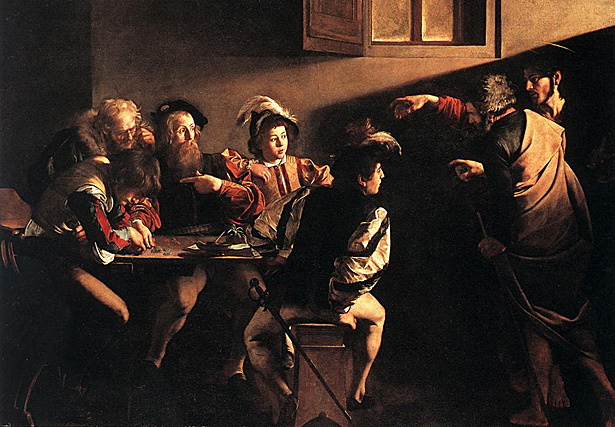
The Calling of Saint Matthew is a masterpiece by Michelangelo Merisi da Caravaggio completed in 1599-1600 for the Contarelli Chapel in the church of the French congregation, San Luigi dei Francesi in Rome. Over a decade before, Cardinal Matteu Contreil (in Italian, Matteo Contarelli) had left funds and specific instructions for the decoration of a chapel based on themes of his namesake. Decoration of the dome was started with frescoes by the late Mannerist artist, and one of the most popular painters in Rome at the time, Cavalier D'Arpino, Caravaggio's former employer. But with the elder painter busy with royal and papal patronage, Cardinal Francesco Del Monte, Caravaggio's patron and also the prefect of the Fabbrica of St Peter's (the Vatican office for Church property), intervened to obtain for Caravaggio his first major church commission and first painting with more than a handful of figures.
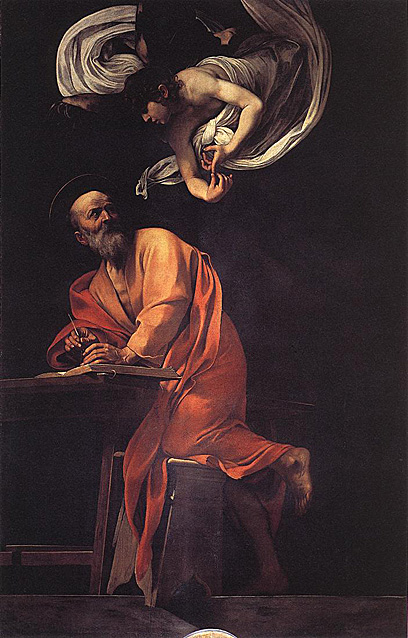
The Inspiration of Saint Matthew (1602) is a painting by the Italian master Caravaggio. Commissioned by the French Cardinal Matteo Contarelli, the canvas hangs in Contarelli chapel altar in the church of the French congregation San Luigi dei Francesi in Rome, Italy. It is one of three Caravaggio canvases in the chapel: hanging between the larger earlier canvases of The Martyrdom of Saint Matthew, and The Calling of Saint Matthew. This was not an easy commission for Caravaggio, and at least two of the three paintings had to be either replaced of repainted to satisfy his patron, the Cardinal Del Monte.
It is instructive to compare the two versions of the latter painting to see how provocative and controversial Caravaggio was in his time. Unfortunately, the first, rejected, version of this theme was destroyed in World War II, and we only have black and white reproductions. In the first version, the angel invades St Matthew's personal space and indulges in what appears more an erotic nudging than divine inspiration. The nubile angel intertwines with the old man, apparently whispering inspiration into his ear. The rejected painting can be compared to the earlier Caravaggio canvas of the Rest on the Flight into Egypt.
In the work featured on the altar, the angel belongs to an aerial and sublime dimension, enveloped in an encircling rippled sheet. The restless Matthew leans to work, as the angel enumerates for him the work to come. All is darkness but for the two large figures. Matthew appears to have rushed to his desk, his stool teetering into our space. His expression is sober.
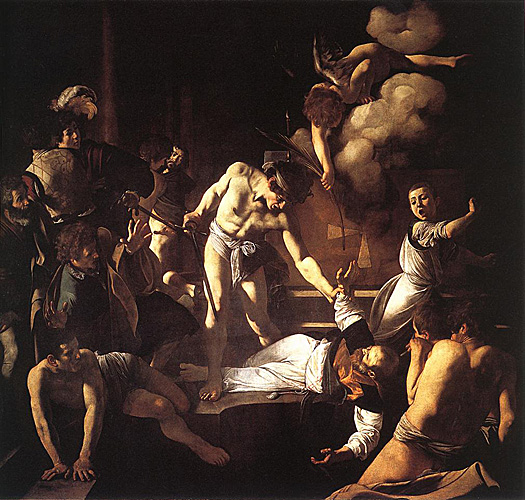
The painting shows the martyrdom of Saint Matthew the Evangelist, author of the Gospel of Matthew. According to tradition, the saint was killed on the orders of the king of Ethiopia while celebrating Mass at the altar. The king lusted after his own niece, and had been rebuked by Matthew, for the girl was a nun, and therefore the bride of Christ. Cardinal Contarelli, who had died several decades earlier, had laid down very explicitly what was to be shown: the saint being murdered by a soldier sent by the wicked king, some suitable architecture, and crowds of onlookers showing appropriate emotion.
The commission (which, strictly speaking, was from his patron, Cardinal Francesco Maria Del Monte, rather than from the church itself), caused Caravaggio considerable difficulty, as he had never painted so large a canvas, nor one with so many figures. X-rays reveal two separate attempts at the composition before the one we see today, with a general movement towards simplification through reduction in the number of figures, and reduction - ultimately elimination - of the architectural element.
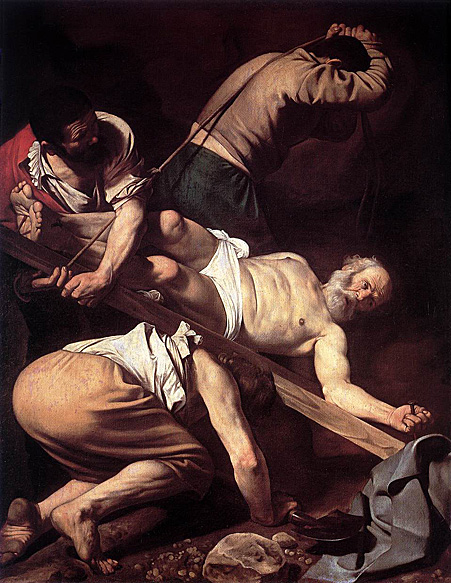
The Crucifixion of St. Peter is a work by Michelangelo Merisi da Caravaggio painted for the Cerasi Chapel of Santa Maria del Popolo in Rome. Across the chapel is a second Caravaggio depicting the The Conversion of Saint Paul on the Road to Damascus (1601).
The painting depicts the martyrdom of St. Peter by crucifixion - Peter asked that his cross be inverted so as not to imitate his master, Christ, hence he is depicted upside-down. The large canvas shows Romans, their faces shielded, struggling to erect the cross of the elderly but muscular St. Peter. Peter is heavier than his aged body would suggest, and his lifting requires the efforts of three men, as if the crime they perpetrate already weighs on them. This crucifixion is bloodless but not painless.
The two saints, Peter and Paul, together represent the foundations of the Catholic church, Peter the 'rock' upon which Christ declared his Church to be built (Gospel of Matthew 16:18), and Paul who founded the seat of the church in Rome. Caravaggio's paintings were thus intended to symbolize Rome's (and Cerasi's) devotion to the Princes of the Apostles in this church which dominated the great piazza welcoming pilgrims as they entered the city from the north, representing the great Counter-Reformation themes of conversion and martyrdom.
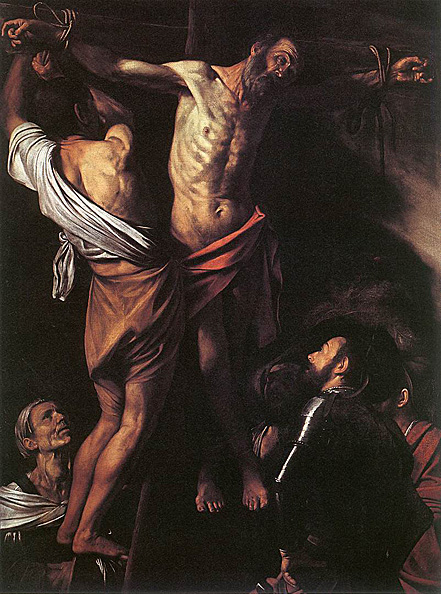
Saint Andrew was sentenced by the proconsul in Patras to be crucified for attempting to convert the Greeks to Christianity. Although the proconsul soon rescinded the order, Andrew still asked to be put to death like Christ. While hanging on the cross, Andrew preached to a crowd of 20,000 people for two days. When his executioners tried to remove him, they were paralyzed by a mysterious force. Upon finishing a prayer on the third day, Andrew was enveloped by a dazzling light and took his last breath. This painting is perhaps the finest example in North America of Caravaggio's mature style. The artist likely painted it during his late years of exile in Naples, where he fled after killing a man in a fight in Rome. His dramatic style of presenting stories with powerful contrasts of light and dark-along with the intense realism of his earthy figures initiated a new movement in European art that influenced artists from Spain to the Netherlands.
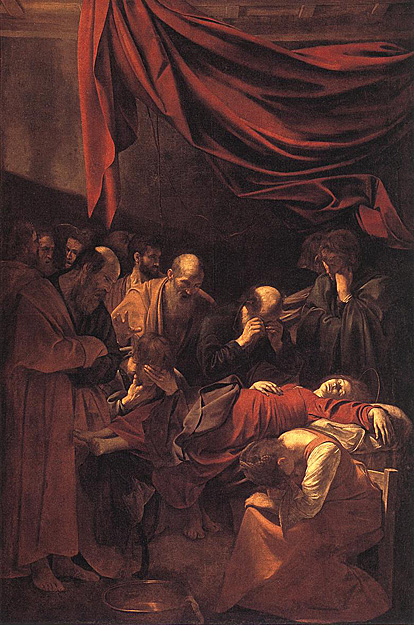
The Death of the Virgin (1606) is a painting completed by the Italian Baroque master Caravaggio. It is a near contemporary with the Madonna with Saint Anne now at the Galleria Borghese. It was commissioned by Laerzio Cherubini, a papal lawyer, for his chapel in the Carmelite church of Santa Maria della Scala in Trastevere, Rome.
The depiction of the Death of the Virgin caused a contemporary stir, and was rejected as unfit by the parish. Subsequently, upon the recommendation by Peter Paul Rubens, who praised it as one of Caravaggio's best, the painting was bought by Charles I, Duke of Mantua. It then travelled to the Court of Charles I of England, and finally to France. Today it hangs in the Louvre. Prior to leaving Rome, it was exposed at the Academy of Painters for under two weeks, however, by then, Caravaggio had fled Rome, never to publicly return. During one of his frequent brawls in Rome, the mercurial and impulsive Caravaggio killed a man, Ranuccio Tomassoni, during a sword fight after a tennis game.
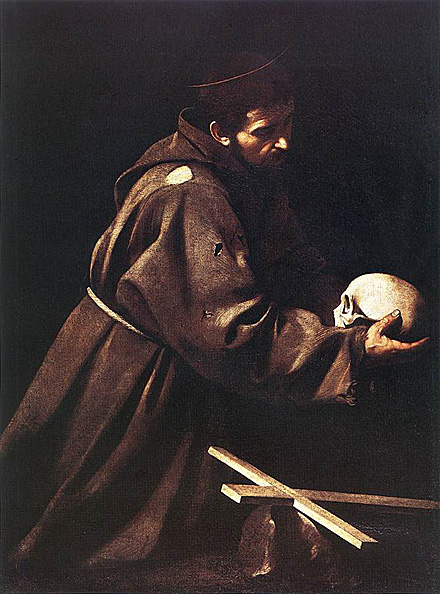
The painting is unrecorded and therefore difficult to date, or even to distinguish the original from later copies. John Gash identifies a version in the Chiesa dei Cappuccini as a good copy of a lost original identified by some scholars with a painting in the Church of San Pietro, Carpineto Romano (Museo di Palazzo Venezia). Helen Langdon, treating the same painting in her biography Caravaggio, refers to the version in Galleria Nazionale d'Arte Antica, in the Palazzo Barberini. St Francis's life of poverty and humility was a popular subject in Caravaggio's age. Peter Robb makes the point that St Francis of Assisi, together with John the Baptist and St Jerome, "...make up the trio of alienated males, young, mature and old, brooding and remote from human society, that M (i.e. Caravaggio) painted again and again", becoming, in effect, private icons for Caravaggio's own troubled life.
In the course of a libel trial in 1603 Caravaggio's friend Orazio Gentileschi stated that he had lent the artist a monk's robe several months before, and this painting could be connected. Gentileschi's evidence seems to be the main argument behind a 1602/1604 date; but Robb, on the grounds of the austere approach and less painterly technique of the work, believes that it may date from 1606, when Caravaggio had fled Rome as an outlaw following a death in a street brawl.


Saint Francis of Assisi in Ecstasy (or The Ecstasy of Saint Francis) is a painting by Caravaggio. It is held in the Wadsworth Atheneum in Hartford, Connecticut. The painting was the first of Caravaggio's religious canvasses, and is thought to date from 1595, when he had recently entered the household of Cardinal Francesco Maria Del Monte. It was presumably painted at the behest of Del Monte, and is thought to be one of the first paintings done by the artist as "Del Monte's painter", as he is believed to have described himself over the next few years while living in Palazzo Madama. It shows Saint Francis of Assisi (the Cardinal's name-saint) at the moment of receiving the signs of the Stigmata, the wounds left in Christ's body by the Crucifixion. The story is told by one of Francis' companions, Brother Leo. In 1224 Francis retired to the wilderness with a small number of his followers to contemplate God. On the mountainside at night Brother Leo saw a six-winged seraph (one of the higher Orders of angels) come down to Francis in answer to the saint's prayer that he might know both Christ's suffering and His love:
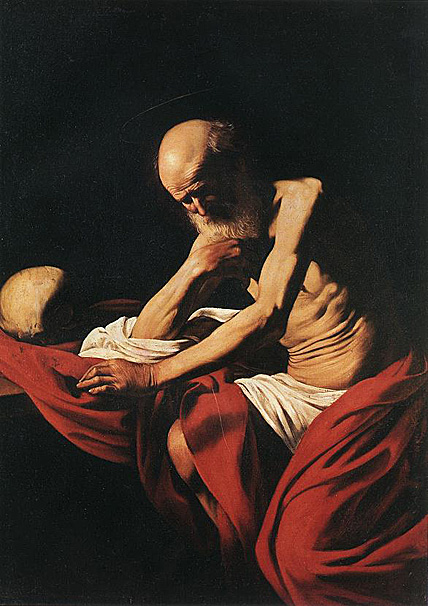
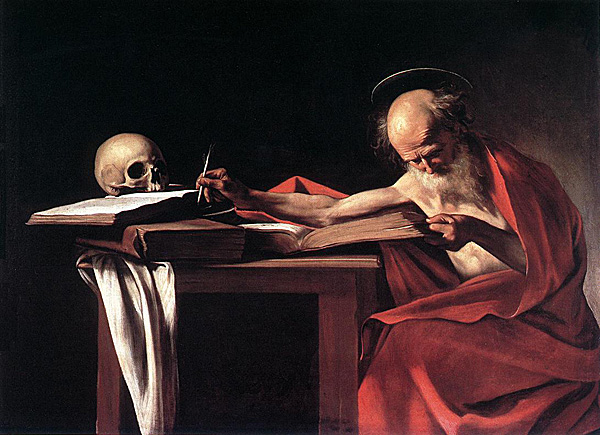
Just as Protestants wished to translate the Bible into local languages to make the Word of God accessible to ordinary believers, so Catholics were keen to justify the use of the standard Latin version, made by St. Jerome in the late 4th century. Jerome had been baptized by one pope, had been given his task as translator by another and had called St. Peter the first bishop of Rome. Among the Latin Fathers of the Church he was a powerful ally against modern heretics, who attacked the cult of the saints, restricted the use of Latin to the learned and viewed the papacy as the whore of Babylon. It was wholly appropriate that this image was bought by Scipione Borghese soon after he was made a cardinal in 1605 by his uncle, the new Pope Paul V.
In pre-Reformation days Jerome was shown with a pet lion and a cardinal's hat. Now Catholic reformers wished to pare religious art down to its essentials, and the good-living cardinal, whose ample features were to be sculpted and caricatured by Bernini, acquired a painting that was as austere as it was somber. The thin old man, whose face is reminiscent of the model who had been Abraham, Matthew and one of the Apostles with Thomas, sits reflecting on a codex of the Bible while his right hand is poised to write. Whereas in the Renaissance, Antonello da Messina and Albrecht Dürer had made him into a wealthy scholar, Caravaggio reduces Jerome's possessions to a minimum. The text he holds open, a second closed one and a third kept open by a skull are perched on a small table. Harsh lighting emphasizes the sinewy muscles of his tired arms and the parallel between his bony head and the skull - man is born to die, but the Word of God lives forever.
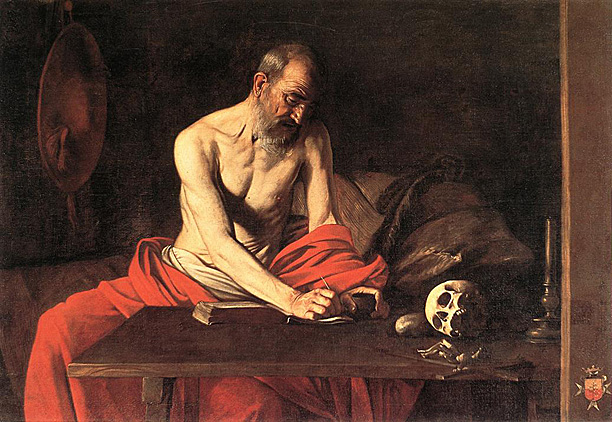
Saint Jerome Writing is a painting by Caravaggio in 1607 or 1608, housed in the Oratory of St John's Co-Cathedral, Valletta, Malta. It can be compared with Caravaggio's earlier version of the same subject in the Borghese Gallery in Rome.
Caravaggio arrived in Malta on 12 July 1607. He had spent the previous months in Naples, where he had sought refuge with his powerful protectors the Colonna family after killing a man in a brawl in Rome the previous year. In Naples he had been an instant success, achieving ten commissions, including a number or large and very prestigious altarpieces, in less than a year, and inspiring a following of Caravaggisti among the city's artists. In short, in Naples he had found professional success, the esteem of fellow-artists, and the support of important patrons. Why then leave all this for a speck of rock inhabited by warrior-monks noted more for their fighting (Peter Robb compares them to the French Foreign Legion) than for their support of the arts? The following summarizes the speculation of recent biographers such as Robb and Helen Langdon: In 1607 Caravaggio was still an outlaw, at risk of being tracked down by his enemies - the family of the man he had killed - and Naples, close to Rome, may have seem comparatively exposed. His patrons and protectors - the Colonnas, the Giustiniani, the banker Ottavio Costa, - had strong links with Malta and the Knights, and it may have been felt that joining the Order would give Carvaggio immediate protection and aid in procuring a Papal pardon for his eventual return to Rome. The Grand Master of the Knights, Alof de Wignacourt, was keen to enhance the prestige of his Order and his capital, and the prospect of having one of the leading artists in Rome and Naples as de facto court painter must have been an appealing one. And so Caravaggio went to Malta.
The coat of arms in the bottom right corner of the painting is that of Ippolito Malaspina, Prior of the Order of the Knights of Saint John (the Knights of Malta) in Naples. Malaspina was a relative by marriage of Caravaggio's patron Ottavio Costa, a friend of his other patrons the Giustiniani brothers, and a cousin of Giovanni Andrea Doria, Prince of Genoa, who two years before had sheltered the artist after an earlier flight from Rome. It's possible that he may have had himself represented as the saint. Saint Jerome was thus a very important painting for the artist.
The subject seems oddly unmartial for a man whose raison d'etre was to fight the Turks - St Jerome was venerated as the translator of the Bible, which he is seen doing here. But Malaspina was not only a famous warrior, he was also a commissioner for the poor, orphans and widows, and the painting may have been intended to emphasize both this aspect of his work and also the asceticism of the Order.
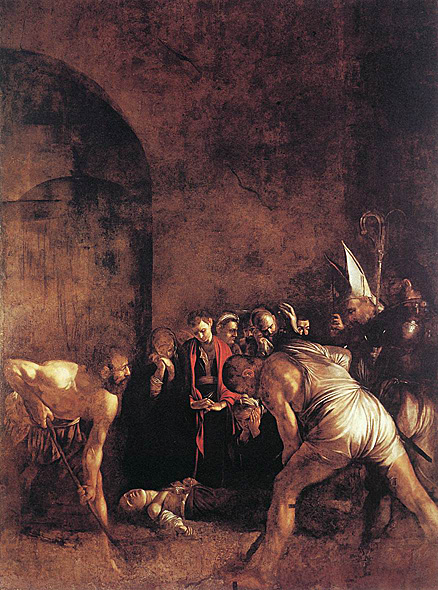
St. Lucy was a local saint of Syracuse, who had been denounced as a Christian by her former suitor and had died in 304 from the tortures inflicted by local pagan authorities. Caravaggio may have worked in haste to produce a picture before the feast of St. Lucy on 13 December. His Sicilian biographer states that he owed the commission to his friend Mario Minniti, who may also have helped him paint it.
Originally, St. Lucy's head was severed from her body but later Caravaggio joined it and left just a slit in the front of her neck - perhaps recalling St. Cecilia, whose still-intact body with a gash in the nape of the neck had been sculpted in 1600 by Maderno. A more local influence was the crypt of the Syracusan church where St. Lucy was buried, because cavernous spaces dwarf the human actors.
The heavily-muscled grave-diggers emerge from murky shadows, the mourners are so much smaller that they seem placed some distance away, the officer directing operations beside the bishop is obscured and only the young man above the saint stands out poignantly in his red cloak. Characteristically, light imitates the action of the sun by falling from the right. The scene takes the viewer back to the age of the Church of the catacombs.
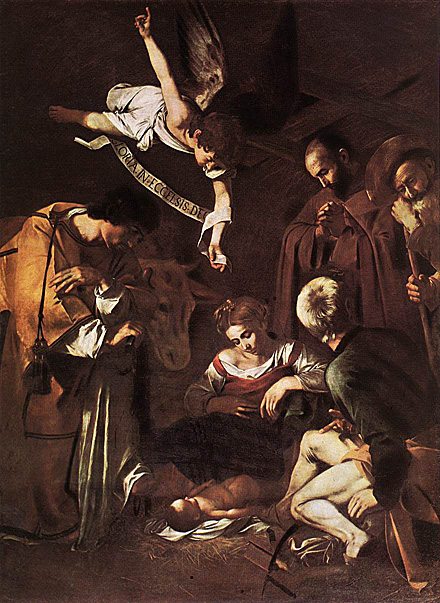
It was stolen on October 16, 1969 from the Oratory of San Lorenzo in Palermo, Sicily. The painting is large measuring almost six square meters and hung above the altar. Probably because of its size, it was removed from its frame by the thief or thieves before being taken out of the church. After it was stolen, the Oratory was pillaged of other art, along with choir stalls of carved and gilded wood and benches inlaid with precious woods and mother of pearl.
The local Sicilian Mafia is generally considered to be the prime culprits in the theft although nobody actually knows who committed the crime. The whereabouts of the work remain unknown to this day. Rumors of its destruction during the theft or subsequently in a 1980 earthquake have circulated from time to time as has the notion that the masterpiece is now hidden abroad. In 1996, Francesco Marino Mannoia, an informant and former member of the Sicilian Mafia, claimed he had stolen the painting as a young man on the orders of a high-ranking mobster, but other sources say it was stolen by amateurs and then sold on to various Mafiosi; at one point it is said to have ended up in the hands of Rosario Riccobono, who was killed in 1982, after which it passed on to Gerlando Alberti.
The Nativity is today the most famous unrecovered stolen painting and the FBI continues to list the work on their art thefts listings site quoting its value at $20 million. Worth is a moot point as the notoriety of the masterpiece makes it almost unsellable.
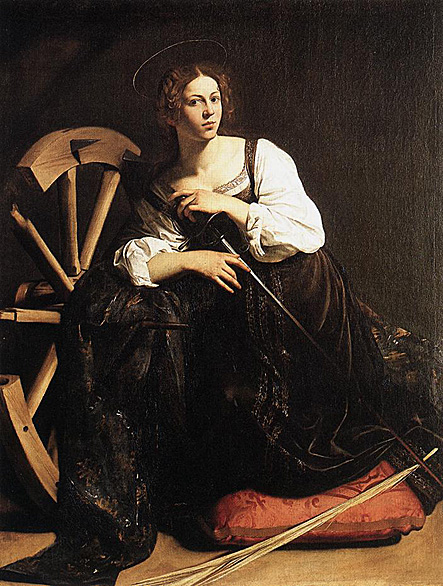
Saint Catherine of Alexandria is an oil painting by Caravaggio. It is part of the Thyssen-Bornemisza Collection of Madrid. The painting formerly belonged to Cardinal Francesco Maria Del Monte, Caravaggio's first important patron.
Saint Catherine of Alexandria was a popular figure in Catholic iconography. She was of noble origins, and dedicated herself as a Christian after having a vision. At the age of 18 she confronted the Roman Emperor Maximus (presumably this refers to Galerius Maximus), debated his pagan philosophers, and succeeded in converting many of them to Christianity. Imprisoned by the emperor, she converted his empress and the leader of his armies. Maximus executed her converts (including the empress) and ordered that Catherine herself be put to death on a spiked wheel. The wheel reportedly shattered the moment Catherine touched it. Maximus then had her beheaded. She became patron saint of libraries and librarians, as well as teachers, archivists, and all those associated with wisdom and teaching, and all those whose livelihoods depended upon wheels. The year of her martyrdom was traditionally held to have been 305, (the year of a major persecution of Christians under Galianus), and her feastday was celebrated on 25 November. In 1969 the Church, persuaded by the overwhelming opinion of historians that Catherine had probably never existed, removed her from the calendar of saints; by 2002, while the historians had not changed their minds, the Church had, and she was reinstated. Her qualities are supposed to be those of beauty, fearlessness, virginity, and intelligence.
Caravaggio shows Catherine with her symbols of martyrdom, the wheel and sword, as a single female figure in an interior devoid of architectural allusions. The image appears with a boldness and an immediacy that combine the nobility of the subject (St. Catherine was a king's daughter) with the almost plebeian pride of the model (she has been identified as Fillide Melandroni, a famous courtesan who frequented the palazzi of Del Monte and other patrons of the arts). The breadth of conception and realization, and the perfect mastery of a very difficult composition (the figure and objects completely fill the painting, in a subtle play of diagonals) are striking. Caravaggio here chose a "grand" noble approach that heralds the great religious compositions he would soon do for San Luigi dei Francesi. The extraordinary virtuosity in the painting of the large, decorated robe is absorbed as an integral part of the composition. This is something his followers would not often succeed in doing, for they frequently dealt with the single components of the painting individually, with adverse effects on the unity of the whole.
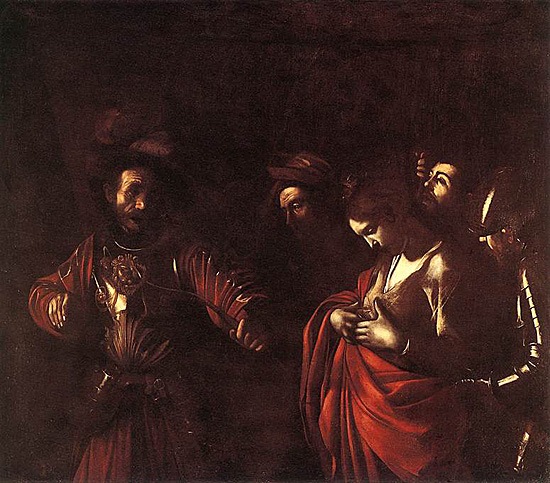
The holy Ursula, accompanied by eleven thousand virgins, was captured by the Huns. The eleven thousand virgins were slaughtered, but the king of the Huns was overcome by Ursula's modesty and beauty and begged her forgiveness if only she would marry him. Ursula replied that she would not, upon which the king transfixed her with an arrow.
Saint Ursula was done in 1610 in Naples for Marcantonio Doria, a twenty-five year old nobleman from Genoa. Doria had become an ardent collector of Caravaggio's work, and he commissioned the painting to mark the entry of his stepdaughter into a religious order as Sister Ursula. The date of the painting can be located at shortly prior to 11 May 1610, when Doria's agent in Naples wrote to his master that the painting was finished. There had been a slight accident, the agent wrote, when he had tried to hasten the drying by leaving it out in the sun the day before, softening the varnish. The agent told Doria not to worry as he would take it back to Caravaggio to be fixed and, in fact, Doria should commission more works from the artist as "people are fighting over him and this is a good chance." It was received in Genoa on 18 June and Doria was delighted, placing it with his Raphaels and Leonardos and his vial of the authentic blood of John the Baptist.
Saint Ursula was one of the last paintings ever made by Caravaggio. In July he set off by boat to receive a pardon from the Pope for his part in the death of a young man in a duel in 1606. But instead of the pardon, he died, exactly how is unclear, although a fever is most frequently quoted as the cause, at Porto Ercole, on the coast north of Rome.
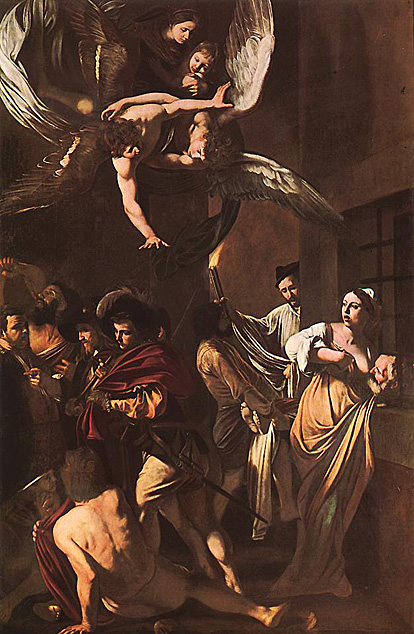
From the fiefs of the Colonna family Caravaggio took refuge in Naples, in 1606. There he began to work again with his usual, astounding speed. Early in January 1607 he was paid for the immense altarpiece commissioned to him by the Pio Monte di Misericordia (where it may still be seen today). The painting shows the Seven Acts of Mercy. It is very complicated in its organization. Caravaggio actually had to add a series of figures (two angels and the Madonna and Child, the latter painted later) in the upper part of the painting, which make the composition of the picture the most complex, perhaps, in any of his works. Caravaggio did not paint exemplary episodes intended to stir the viewer to religious piety through the illustrative emphasis of gestures and feelings. Rather, he entrusted the educational effectiveness of his works to the evidence of things in themselves, in the conviction that nothing should be added above and beyond what is already contained in the intrinsic eloquence of the various poses.
The seven acts of mercy represented on the painting are the following. On the right appear the (1) burial of the dead and the episode of the so-called Carita Romana (Cimon's daughter giving her father suck in prison), which contains at once the two charitable acts of (2) visiting prisoners and (3) feeding the hungry. (4) Dressing the naked appears in the foreground, symbolized by St. Martin and the beggar. Next to this scene, the host and St. James of Compostela allude to the (5) offering of hospitality to pilgrims. (6) Relieving the thirsty is represented by Samson drinking from the ox jaw. The youth on the ground behind the beggar of St. Martin may also represent the merciful gesture of (7) caring for the sick.
We readily apprehend the artist's power of synthesis, which concentrates a conceptual content that is potentially quite dispersive, in the model behavior of a few figures. The large painting was widely copied and studied by seventeenth-century Neapolitan painters, who drew ideas and formal devices from it.

Alof de Wignacourt joined the Order of the Knights of Saint John (the Knights of Malta) in 1564, aged seventeen, and distinguished himself the next year at the Great Siege of Malta, when the Turks took possession of most of the island. He was elected Grand Master in 1601, determined to enhance the prestige of the Order and its new post-siege capital, Valletta. It was not surprising, therefore, that he would welcome the opportunity to have at his court the most famous painter in Rome and Naples, Michelangelo da Caravaggio.
Caravaggio arrived in Malta from Naples in July 1607, and, according his early biographers Giovanni Baglione and Giovanni Bellori, began at once with portraits of Wignacourt and other knights from the highest ranks of the Order. This famous portrait shows the Grand Master in formal armor, holding his baton of command, every gleaming inch an image of the military might of the Knights. At the time he was about sixty years old. He had strengthened the fortifications of the island, built an aqueduct to guarantee water to the city, and launched several attacks on the Turks. He had turned the Knights into a sovereign power, making himself in effect a prince answerable to no-one except the pope, with his own increasingly wealthy court.
One of his innovations had been to surround to himself with young pages, in imitation of the fashion of the princely courts, and his pages were, of course, taken from the most noble Catholic families of Europe. According to John Gash and others the page in the portrait is probably Nicholas de Paris Boissy, a French aristocrat destined for a distinguished career - he became Grand Prior of France in 1657. He is placed a little awkwardly within the composition - his feet are aligned with the feet of de Wignacourt, as if standing beside de Wignacourt, but his hand and the helmet overlap de Wignacourt's elbow, giving the impression that from the waist up he is in front of the knight. The fact can be explained by Caravaggio's practice of painting separately from live models - de Wignacourt and the page were apparently not together in the studio at the same time.
The boy's lively expression and alert gaze make him an attractive subject in his own right, to the extent that he was several times copied by later artists visiting Malta. Wignacourt, encased in splendid black and gold Milanese armor, stares upwards and outwards out of the frame in a dignified manner that invites the viewer to gaze upon him in awe, leaving the page, with his look of boyish interest, as the sole thoroughly human presence, and a far more sympathetic one than the self-conscious man of steel. The double-portrait with the pageboy was an unusual combination for the time. It may have been ordered by Wignacourt to stress the dignity of his court, or Caravaggio may have been inspired by a painting by Titian that he could have seen in his youth in Milan, The Speech of Alfonso d'Avalos, showing the Spanish governor of the city addressing his knights with a page beside him holding his helmet. The poses of d'Avalos and his page mirror exactly those of de Wignacourt and his page, the governor taken up with his soldiering while the boy gazes curiously at the artist and the viewer. As a reward for this painting Wignacourt made the artist a knight, but within three months Caravaggio had fled Malta in disgrace.
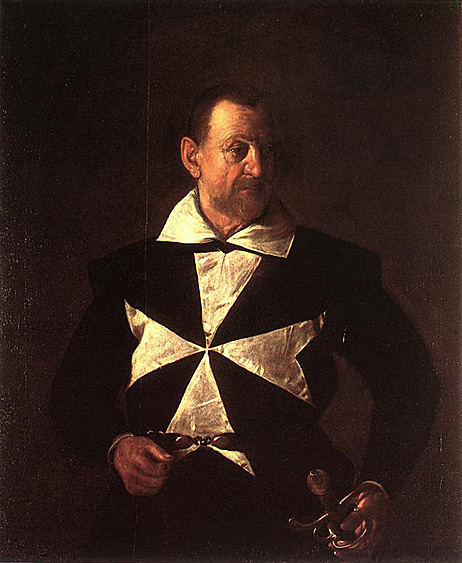
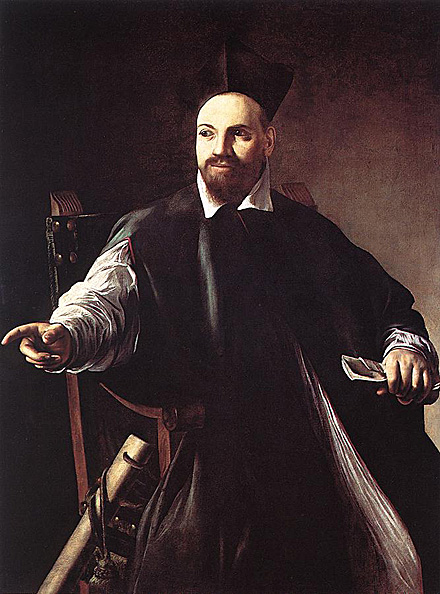
Portrait of Maffeo Barberini (c. 1598) is a painting by Caravaggio. It is held in a private collection in Florence. Barberini, 30 years old and from an eminent Florentine family, was a rapidly rising Church prelate, a friend of Caravaggio's patron Cardinal Francesco Maria Del Monte, and himself a poet and patron of the arts. Barberini's support would continue into later years - in 1603 he commissioned a Sacrifice of Isaac from Caravaggio. In 1623 he became Pope as Urban VIII

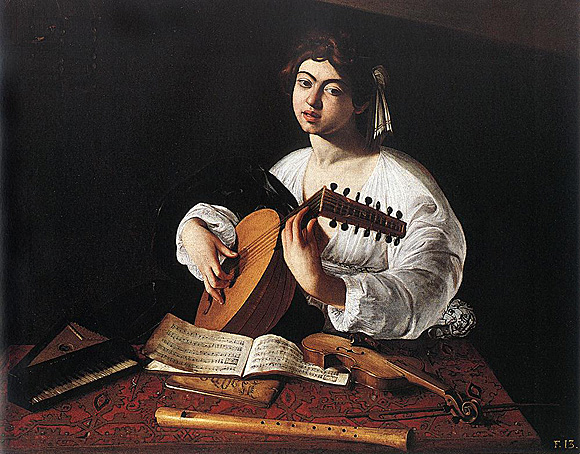
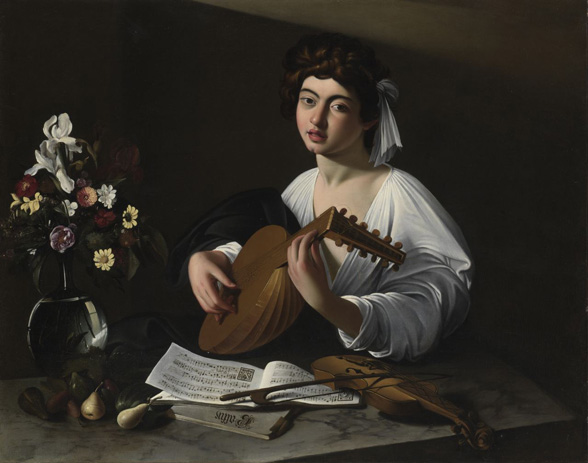
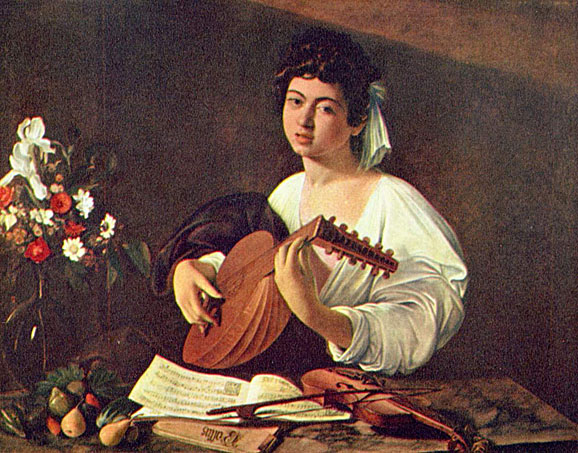
Caravaggio's early biographer Giovanni Baglione gives the following description of a piece done by the artist for his patron Cardinal Francesco Del Monte:
("He also painted [for Cardinal Del Monte] a young man, playing the Lute, who seemed altogether alive and real with a carafe of flowers full of water, in which you could see perfectly the reflection of a window and other reflections of that room inside the water, and on those flowers there was a lively dew depicted with every exquisite care. And this (he said) was the best piece that he ever painted.)"
The painting exists in three versions. All show a boy with soft facial features and thick brown hair, accompanying himself on the lute as he sings a madrigal about love. As in the Uffizi Bacchus, the artist places a table-top in front of the figure. In the Hermitage and Badminton House versions it is bare marble, with a violin on one side and a still life of flowers and fruit on the other. In the Wildenstein version the table is covered with a carpet and extended forwards to hold a tenor recorder, while the still life is replaced by a spinetta (a small keyboard instrument) and a caged songbird. The musical instruments are valuable and probably came from Del Monte's personal collection.
The Lute Player (detail from the Hermitage version).The Hermitage and Badminton House versions show madrigals by Jacques Arcadelt (1515-1568), and the visible text reads in part:
"Vous savez que je vous aime et vous adore...Je fus votre."
"You know I love you and adore you...I was yours".
The Wildenstein version shows songs by a native Florentine (Francesco de Layolle) on a text by Petrarch:
Laisse le voile ('Let go the veil') and Pourquoi ne vous donnez-vous pas?
'Why do you not give yourself?' by Giachetto Berchem (Jacquet de Berchem.
The flowers and damaged fruit, and the cracked body of the lute, suggest the theme of transience: love, like all things, is fleeting and mortal. The choice of Franco-Flemish composers over native Italians - only Layolle was a native Italian - no doubt reflects the cultural (and political) affiliations of the pro-French Del Monte-Giustiniani circle.

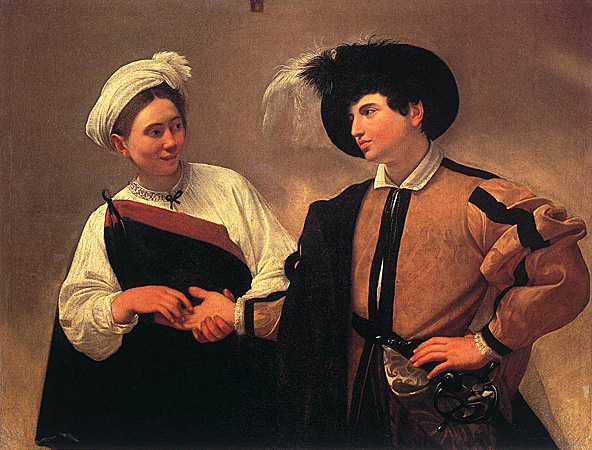
The 1594 Fortune Teller aroused considerable interest among younger artists and the more avant garde collectors of Rome, but, according to Mancini, Caravaggio's poverty forced him to sell it for the low sum of eight scudi. It entered the collection of a wealthy banker and connoisseur, the Marchese Vincente Giustiniani, who became an important patron of the artist. Giustiniani's friend, Cardinal Francesco Maria Del Monte, purchased the companion piece, Cardsharps, in 1595, and at some point in that year Caravaggio entered the Cardinal's household. For Del Monte Caravaggio painted a second version of The Fortune Teller, copied from the Giustiniani but with certain changes. The undifferentiated background of the 1594 version becomes a real wall broken by the shadows of a half-drawn curtain and a window sash, and the figures more completely fill the space and defining it in three dimensions. The light is more radiant, the cloth of the boy's doublet and the girl's sleeves more finely textured. The dupe becomes more child-like and more innocently vulnerable, the girl less wary-looking, leaning in towards him, more in command of the situation. The man's sword at Mario's boyish hip now juts out towards the viewer, defining the scene in real space, and seems more a danger to himself than to any possible opponent.

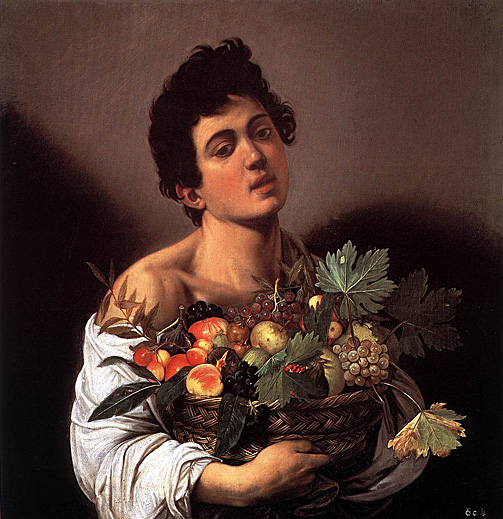
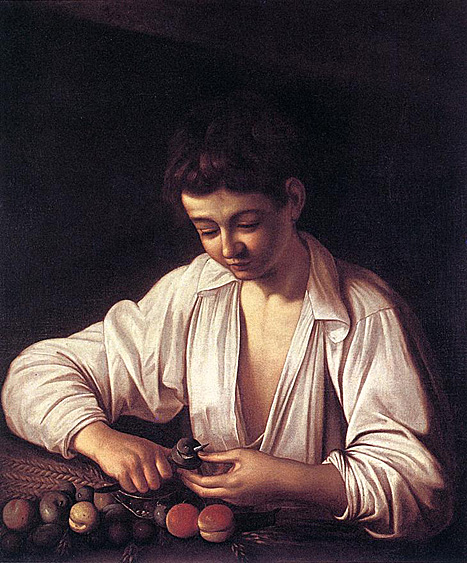
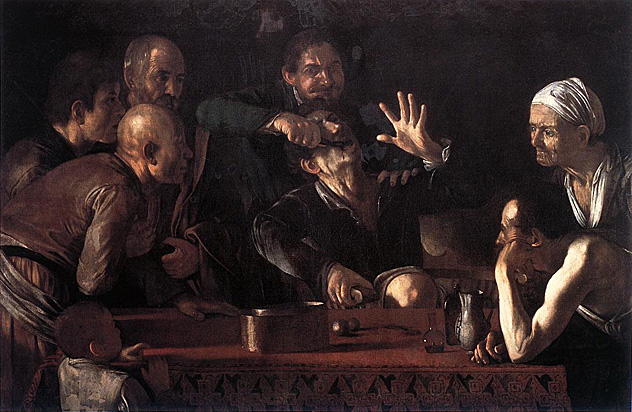
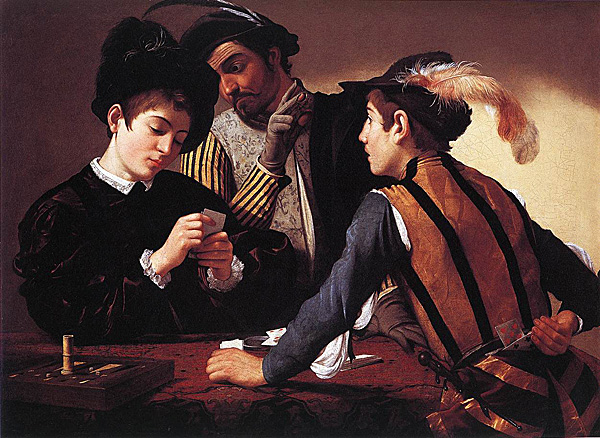
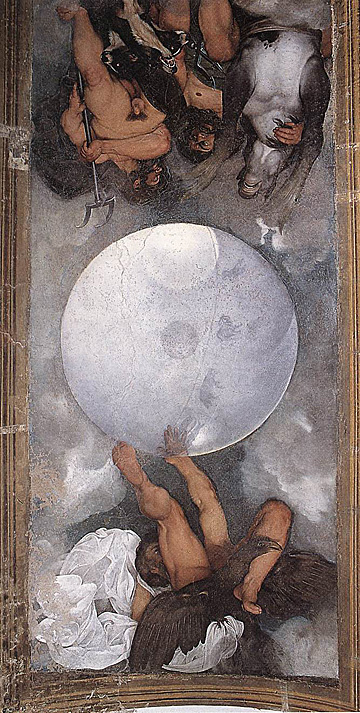

One is bewildered by this painting, by the absolute freedom that the subject obviously enjoys, detaching himself from mere mortals who must obey the laws of nature. The figure is in the act of mocking the world with a complete impunity, a self-assurance that produce a mixture of astonishment and envy. The figure has a torso that recalls Michelangelo's Victory.
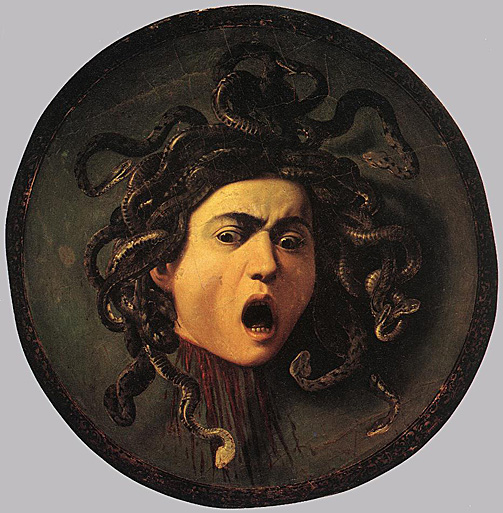
In Greek myth, Perseus used the severed snake-haired head of the Gorgon Medusa as a shield with which to turn his enemies to stone. By the sixteenth century Medusa was said to symbolize the triumph of reason over the senses; and this may have been why Cardinal Del Monte commissioned Caravaggio to paint Medusa as the figure on a ceremonial shield presented in 1601 to Ferdinand I de' Medici, Grand Duke of Tuscany. The poet Marino claimed that it symbolized the Duke's courage in defeating his enemies.
As a feat of perspective, the picture is remarkable, for out of the apparently concave surface of the shield - in fact convex- the Gorgon's head seems to project into space, so that the blood round her neck appears to fall on the floor. In terms of its psychology, however, it is less successful. The boy who modeled the face (in preference to a girl) is more embarrassed than terrifying. For once Caravaggio cannot achieve an effect of horror; he was to find in the legends of the martyrs a more powerful stimulus to the dark side of his imagination than classical myth.

Analysis of the details of execution, stylistic comparison to other works of Caravaggio, and the iconographic innovativeness of the subject all lead to acceptance of the Narcissus as a work of Caravaggio. On the subject of invention, it suffices to mention the exceptional the double figure which - like a playing card - turns on the fulcrum of the highlight knee at the centre of the composition.
The work belongs to the years between 1597 and 1599, a transitional period of Caravaggio's career that is still not entirely sorted out or fully understood. It is a moment in which Caravaggio tended towards a magical sense of atmosphere, suspense, and introspection: still strongly influenced by the Lombard style of Moretto and Savoldo, he is also testing the infinite possibilities of light and shadow. Dating from the same phase of Caravaggio's career are the Lute Player, the Doria Magdalene, and above all the Thyssen St Catherine and Detroit Magdalene, with which our canvas has many connections and resonances.
The Origin of Narcissus: Ovid's, from his Metamorphoses; Pausanias', from his Guide to Greece, (9.31.7); and one found among the Oxyrhynchus papyri.
Pausanias locates the spring of Narcissus at Donacon 'Reed-bed' in the territory of the Thespians. Pausanias finds it incredible that someone could not distinguish a reflection from a real person, and cites a less known variant in which Narcissus had a twin sister. Both dressed similarly and hunted together. Narcissus fell in love with her. When she died, Narcissus pined after her and pretended that the reflection he saw in the water was his sister.
As Pausanias also notes, yet another tale is that the Narcissus flower was created to entice Demeter's daughter Persephone away from her companions to enable Hades to abduct her.
…and the myth began like this. In a valley, lived a beautiful nymph named Echo who loved to chatter. However, a sad "spell" fell on her. Echo could only repeat, very faintly, the last few words of the sentence. In the same valley lived a good-looking youth named Narcissus, who was so charming that every maiden who saw him, fell in love with him in less than a second. Narcissus, however, was consumed with his own desires and loved no one else. He rejected all his admirers.
One day, Narcissus, while with his friends, was walking and saw a flower. After stopping to pluck it, he lost sight of his friends. In pursuing them, he walked past the tree Echo was resting. In an instant, Echo fell in love with him. She could not bear to lose sight of him, so she followed him without letting him know. She wanted to speak to him, but because she was under the spell, she could not.
While Narcissus was parting some branches to find his friends he said, "Is anybody here?" "Here!" Echo answered faintly. Narcissus looked around not knowing who the voice belonged to, and said, "Where are you? Come here!" whereupon Echo responded, "Here!" Narcissus couldn't see anyone, but he knew that there was someone close by, so he continued questioning and calling. Each time Echo answered with his last words. She didn't dare show herself, but she just couldn't help answering. After a while, she decided to take the chance. She showed up in front of Narcissus and attempted to embrace him. However, Narcissus rebuffed Echo and ran into the deepest part of the forest.
Narcissus had broken Echo's heart by his rude and unkind actions. She was so hurt that she stopped eating and grew very pale and thin and wasted away. One of the maidens prayed to the gods and goddesses that he was to only love himself and no one else. Nemesis, who was a goddess of punishment, answered her prayer.
One day, when Narcissus became thirsty, he went to a pool to take a drink. Just before he was about to take a sip from the pool, he saw the reflection of his own face, but he didn't know it was only a reflection. He couldn't tear himself away from the appearance in the water. And like Echo, he stopped eating and became really pale and thin and also wasted away. After he died, his body "turned" into a flower that was named after him, Narcissus.
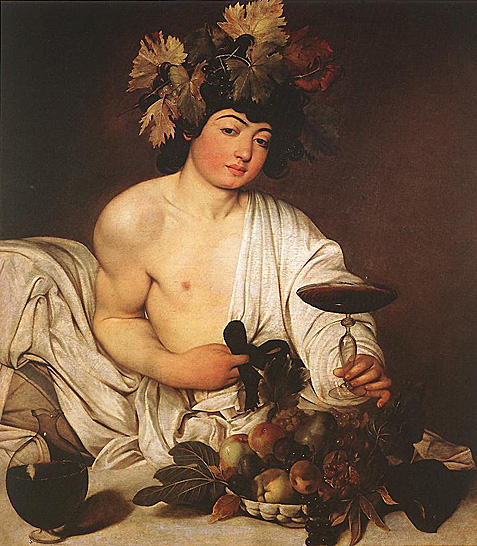
He was also known as Bacchus and the frenzy he induces, bakcheia. He is the patron deity of agriculture and the theatre. He was also known as the Liberator, freeing one from one's normal self, by madness, ecstasy, or wine. The divine mission of Dionysus was to mingle the music of the aulos and to bring an end to care and worry. Scholars have discussed Dionysus' relationship to the "cult of the souls" and his ability to preside over communication between the living and the dead.
In Greek mythology Dionysus is made to be a son of Zeus and Semele; other versions of the myth contend that he is a son of Zeus and Persephone.
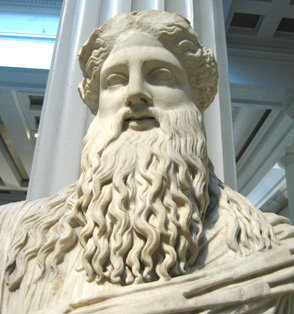
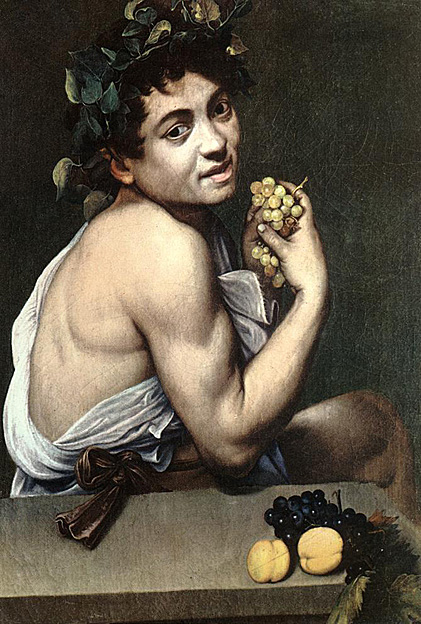
Among Caravaggio's early works, this painting, in which the pose of the arm may recall his debt to the kneeling shepherd in a fresco by Peterzano, belongs to the small group which has always been seen as self-portraits. The livid colors of the subject's face, his teasing smile and the mock seriousness of his mythological dignity all reinforce the attempt to undermine the lofty pretensions of Renaissance artistic traditions. Here is no god, just a sickly young man who may be suffering from the after-effects of a hangover. There is no mistaking the artist's delight in the depiction of the fine peaches and black grapes on the slab, the white grapes in his hand and the vine leaves that crown his hair, but the artist is not content merely to demonstrate his superb technique: he wishes to play an intimate role and only the slab separates him from the viewer. His appearance is striking rather than handsome: he shows both that his face is unhealthy and that his right shoulder is not that of a bronzed Adonis, as convention required, but pale as in the case of any man who normally wears clothes.
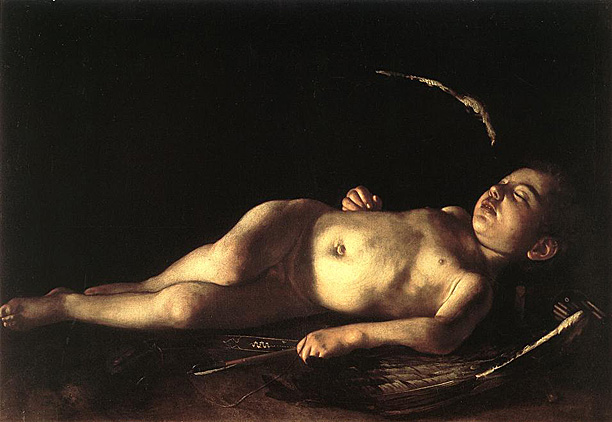
Unlike many of Caravaggio's works, it can be dated accurately. It was commissioned for Fra Francesco dell'Antella, Florentiner Secretary for Italy to Alof de Wignacourt, Grand Master of the Knights of Malta, and an old inscription on the back records that it was painted in Malta in 1608.
The subject of a sleeping Cupid, bowstring broken and arrows cast aside, usually signifies the abandonment of worldly pleasures, and dell'Antella may have commissioned it as a reminder of his vow of chastity.
Source: Art Renewal Center
Source: Web Gallery of Art
Return to Pagina Artis
Return to Bruce and Bobbie's Main Page.